The Solomon Islands are home to a wide variety of beautiful and unique birds. From colorful parrots to majestic eagles to colorful kingfishers, these birds inhabit the islands and make the Solomon Islands a bird-lover’s paradise.
With over 150 species of birds found in the Solomon Islands, there is something for everyone. From the exotic birds of the tropical rainforest to the more common species of the lowland and coastal areas, the Solomon Islands provide an excellent opportunity to observe and appreciate the beautiful birds of the islands.
1. Blyth’s Hornbill
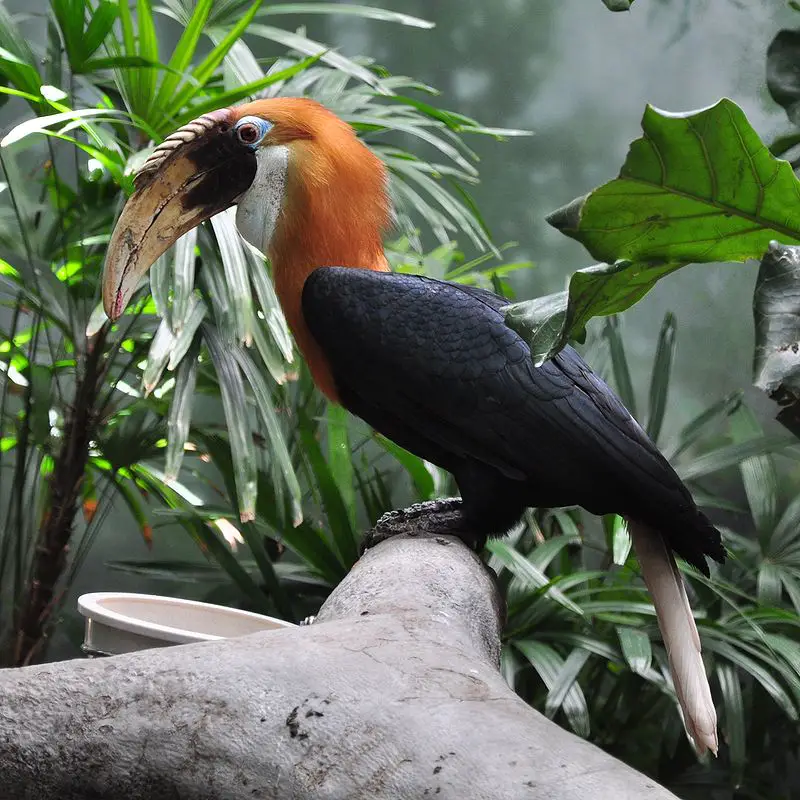
Blyth’s hornbill, or the Papuan Hornbill is a large species of bird that inhabits forests in Wallacea and Melanesia. It is also known as kokomo in Tok Pisin, and was previously placed under the genus Aceros.
This impressive bird has been often confused with its relative -the plain-pouched hornbill (Rhyticeros subruficollis)- but more recently it includes another family member: The Narcondam Hornbill (Rhyticeros narconda).
Blyth’s hornbills are characterized by their long curved beak and wingspan of up to three feet wide; they have dark feathers over most parts of their bodies except for yellowish ones on their tail tip, neck base and chin.
These majestic birds can make quite an impression when flying through a canopy.Scientific classification:
| Kingdom | Animalia |
| Phylum | Chordata |
| Class | Aves |
| Order | Bucerotiformes |
| Family | Bucerotidae |
| Genus | Rhyticeros |
| Species | R. plicatus |
2. Melanesian Megapode
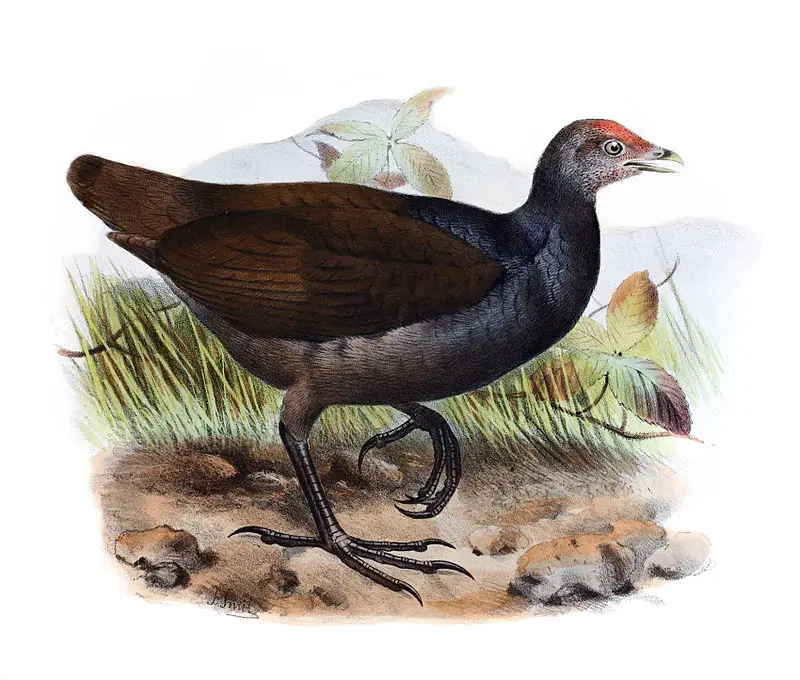
The Melanesian scrubfowl, also known as the Melanesian megapode, is a unique bird species endemic to islands in the Melanesia region.
It has an unusual incubation strategy that involves relying on environmental heat sources rather than sitting on its eggs like most birds do.
This species holds cultural importance for Indigenous peoples of this area and they have two names commonly used to refer it: Megapodi or Scrubfowl.
The megapod has brown feathers with yellowish-buff markings across its body and wings; red legs; long toes for digging; and a black crest at the top of its head.
Its diet consists mostly of fruit seeds, insects, snails and other invertebrates found in leaf litter during their daily search for food through dense vegetation near streams or pools.
All these adaptations make them well suited to live in forests located between oceanic shores up into highland areas surrounded by tropical rainforest habitat .Scientific classification:
| Kingdom | Animalia |
| Phylum | Chordata |
| Class | Aves |
| Order | Galliformes |
| Family | Megapodiidae |
| Genus | Megapodius |
| Species | M. eremita |
3. Black-Faced Pitta
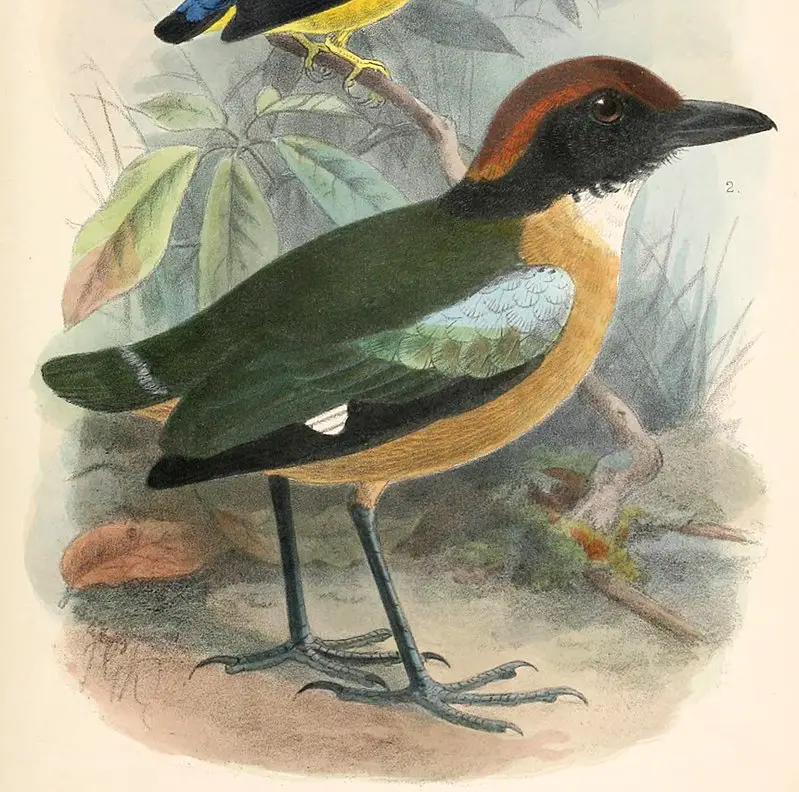
The black-faced pitta is a beautiful bird belonging to the family Pittidae. It can be found in Bougainville Island, Papua New Guinea and Choiseul Island as well as Santa Isabel Island in the Solomon Islands.
Its natural habitat is subtropical or tropical moist lowland forest which unfortunately makes it vulnerable to habitat loss due to deforestation and other human activities such as agriculture.
These birds have stunning blueish plumage with white underparts, bright orange legs, dark eyes surrounded by black feathers on their face; making them quite striking creatures.
They feed mainly on insects but also consume some fruit from time to time . Conservation efforts are highly needed for this species in order for us not lose these wonderful animals foreverScientific classification:
| Kingdom | Animalia |
| Phylum | Chordata |
| Class | Aves |
| Order | Passeriformes |
| Family | Pittidae |
| Genus | Pitta |
| Species | P. anerythra |
Also Featured In: Bougainville Island Birds You Need to See,
4. Buff-Headed Coucal
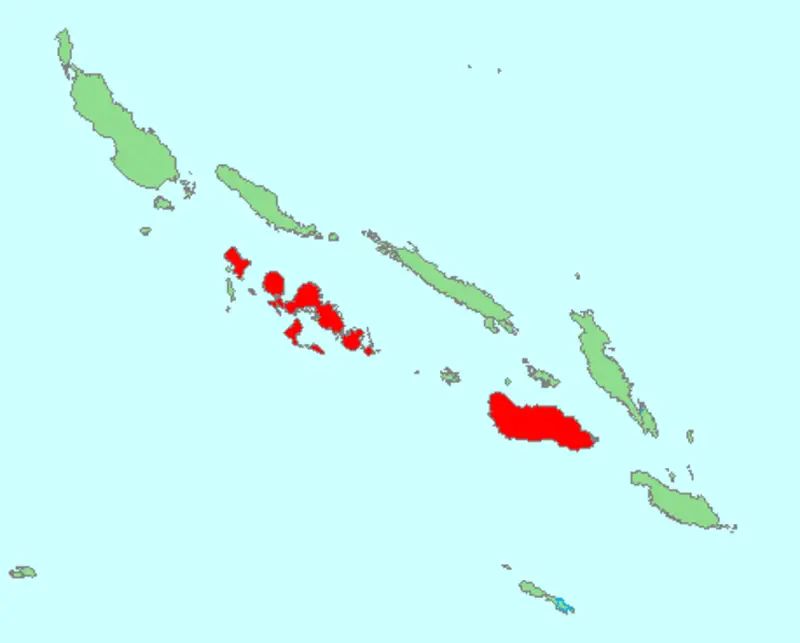
The Buff-headed Coucal is a striking species of bird found in the Solomon Islands. It has a large, buff-coloured head and black wings speckled with white spots.
Its long tail feathers are tipped with white and its beak is curved like that of other coucals.
This species lives in lowland and mountain forests as well as secondary growth areas, where it feeds on insects such as beetles, grasshoppers, ants and termites.
In addition to their diet they also eat small fruits which help them maintain energy levels during cold nights or periods when food is scarce.
A shy but sociable animal, this beautiful bird will often congregate near rivers or wetlands looking for food together while singing melodically throughout the day.Scientific classification:
| Kingdom | Animalia |
| Phylum | Chordata |
| Class | Aves |
| Order | Cuculiformes |
| Family | Cuculidae |
| Genus | Centropus |
| Species | C. milo |
Also Featured In: Guadalcanal Birds You Need to See,
5. Solomons Cockatoo
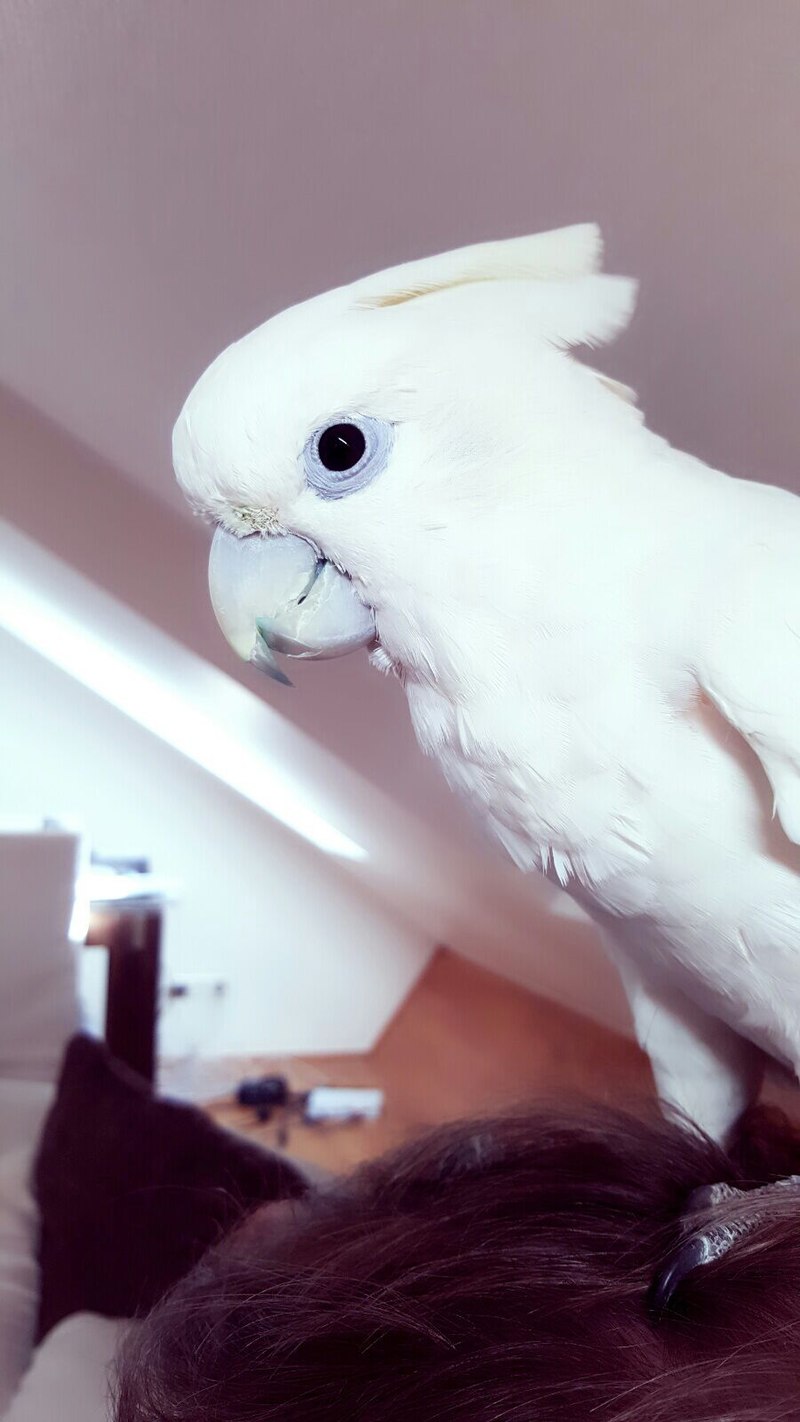
The Solomons cockatoo is a species of white cockatoo endemic to the Solomon Islands archipelago.
It has a broad crest that gives it its name, and stands out from other parrots in the area due to its size – slightly larger than the Tanimbar corella yet smaller than an umbrella cockatoo.
The bird is fondly thought of by locals as being quite sociable, often seen in groups or pairs perched on tree branches or foraging for food together.
Its call sounds like laughter which adds to their playful character. They are common across most areas but absent from Makira Island in the south.
These birds make wonderful pets if given proper care and attention; however their numbers may be declining so potential owners should ensure they source them responsibly before buying one.Scientific classification:
| Kingdom | Animalia |
| Phylum | Chordata |
| Class | Aves |
| Order | Psittaciformes |
| Family | Cacatuidae |
| Genus | Cacatua |
| Subgenus | Licmetis |
| Species | C. ducorpsii |
6. Roviana Rail
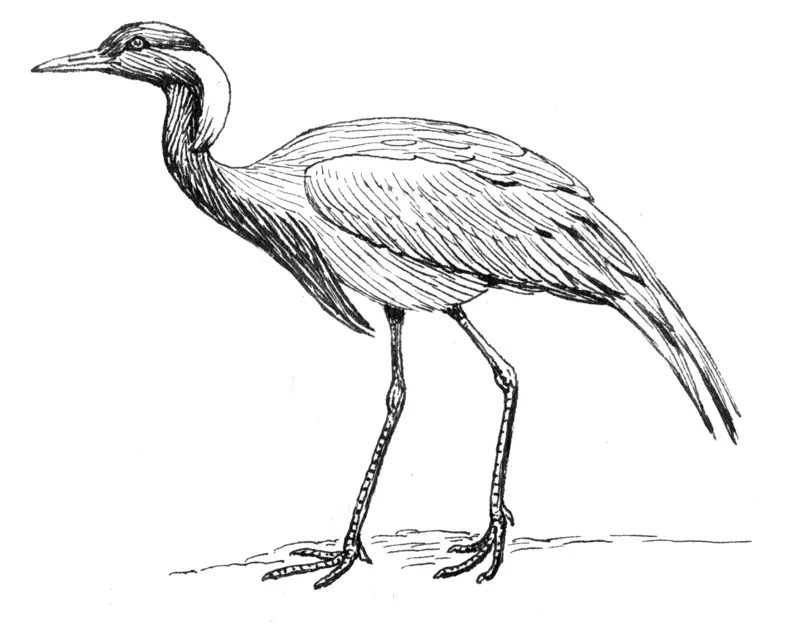
The Roviana Rail is a species of bird found in the Western Province of the Solomon Islands. It has adapted to living in subtropical and tropical regions, including lowland forests, shrublands and plantations.
This small rail has brown feathers with black barring on its back and wings, white underparts and reddish legs.
Its diet consists mainly of insects which it searches for by probing into leaf litter or mud with its bill.
The bird can be seen during both day as well as night time hours but usually remains hidden within dense vegetation due to its shy nature.
Due to habitat destruction caused by human activities such as logging, this species is now threatened with extinction making it important that conservation efforts are put in place if we wish to preserve one of our unique native birds from disappearing forever.Scientific classification:
| Kingdom | Animalia |
| Phylum | Chordata |
| Class | Aves |
| Order | Gruiformes |
| Family | Rallidae |
| Genus | Hypotaenidia |
| Species | H. rovianae |
7. Cardinal Myzomela
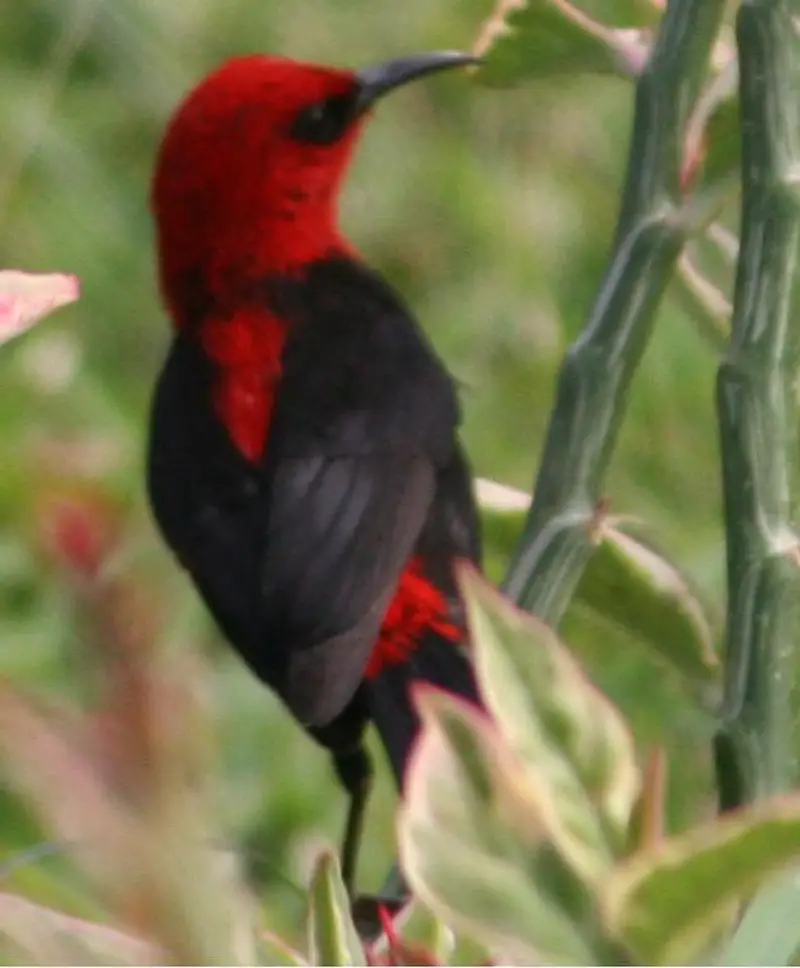
The Cardinal myzomela is a stunning species of bird found in American Samoa, New Caledonia, Samoa, Solomon Islands and Vanuatu.
The male has beautiful scarlet plumage which gave it its name.
It inhabits subtropical or tropical moist lowland forests and mangrove forests. This adaptable species also lives on some Micronesian islands such as Yap.
Its diet consists of nectar from flowers and insects that are caught while foraging among the branches of trees in these habitats.
A shy but energetic bird, the cardinal myzomela often forms flocks with other birds to look for food before returning to roost at nightfall.Scientific classification:
| Kingdom | Animalia |
| Phylum | Chordata |
| Class | Aves |
| Order | Passeriformes |
| Family | Meliphagidae |
| Genus | Myzomela |
| Species | M. cardinalis |
8. Eclectus Parrot
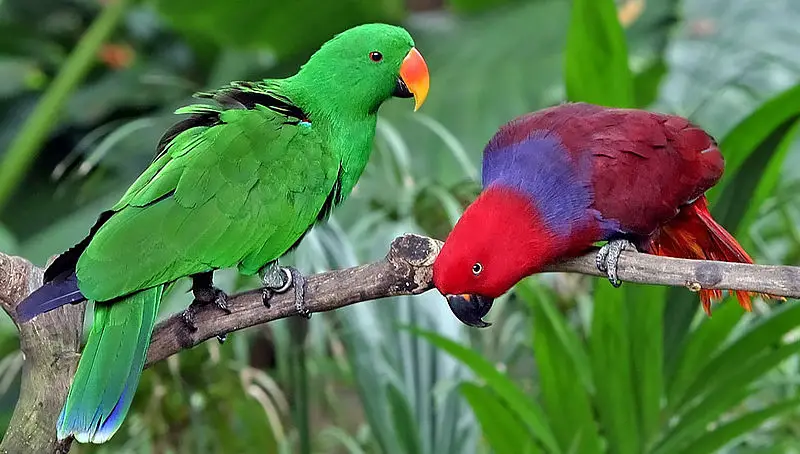
The eclectus parrot is a unique species of bird due to its extreme sexual dimorphism in plumage coloration.
The males have bright emerald green feathers while the females can be seen with vibrant red and purple/blue colors.
It’s natively found from Solomon Islands, Sumba, New Guinea, northeastern Australia and Maluku Islands (Moluccas).
This beautiful parrot has an average lifespan of 30 years in captivity if given proper care and nutrition.
They’re known for their intelligence; they require lots of mental stimulation through playtime as well as physical exercise opportunities to stay healthy both mentally & physically.
Overall this gorgeous bird makes a great pet but needs plenty of attention and dedication.Scientific classification:
| Kingdom | Animalia |
| Phylum | Chordata |
| Class | Aves |
| Order | Psittaciformes |
| Family | Psittaculidae |
| Genus | Eclectus |
| Species | E. roratus |
9. Rufous Fantail
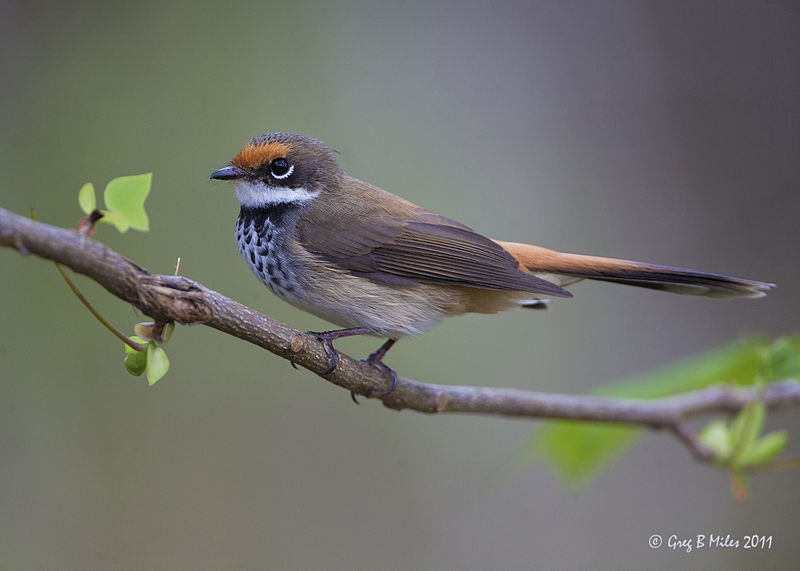
The Rufous Fantail is a small passerine bird found in Australia, Indonesia, Micronesia, New Guinea and the Solomon Islands.
It inhabits rainforests, wet forests, swamp woodlands and mangroves which makes it quite adaptable.
These birds are usually black-breasted with distinctive rufous wings and tail feathers that they use to fan out while looking for food on branches or shrubs.
They also often flick their tails from side to side as they search for insects like flies or moths.
The call of the Rufous Fantail consists of a series of high pitched notes that can be heard during its breeding season from September through February when mating pairs sing together near nesting sites such as tree hollows or rock crevices.
Despite their relatively small size these birds make an impressive presence thanks to their bold colors displayed in flight making them easy to spot even at great distances.Scientific classification:
| Kingdom | Animalia |
| Phylum | Chordata |
| Class | Aves |
| Order | Passeriformes |
| Family | Rhipiduridae |
| Genus | Rhipidura |
| Species | R. rufifrons |
Also Featured In: Guam Birds You Need to See, Birds that Live in Sunshine Coast
10. Yellow-Bibbed Lory
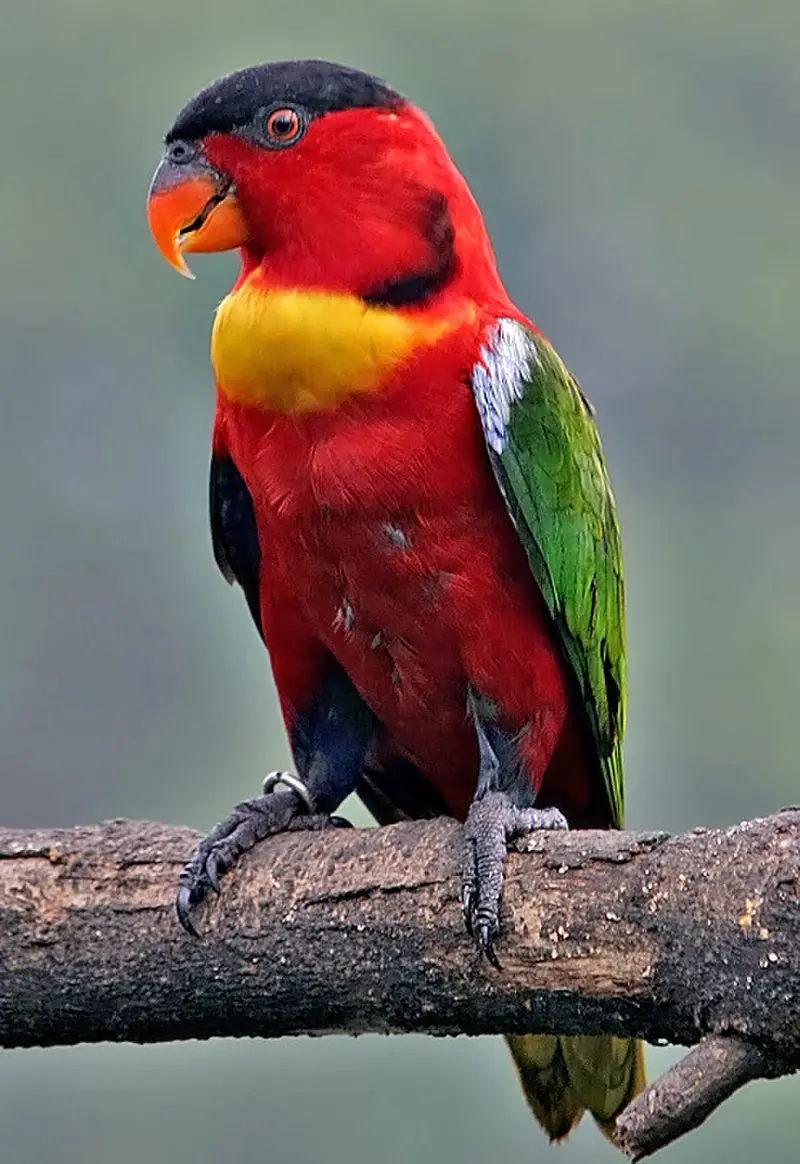
The Yellow-bibbed Lory is a species of parrot endemic to the Southern Solomon Islands. It is around 28 cm in length, and features an impressive plumage of black on top of its head, green wings, yellow transverse band on upper chest and a crescent shaped black patch between each side of its neck.
Its thighs are blue/green with dark grey legs. The beak is grayish horn color with red cere (area above beak).
This stunning bird has great flying skills allowing it to move quickly from tree to tree while searching for food such as fruits or nectar which makes up most part of their diet.
They can also feed on flowers and insects occasionally found near rivers or lakes where they often come together in groups looking for water sources during dry season monthsScientific classification:
| Kingdom | Animalia |
| Phylum | Chordata |
| Class | Aves |
| Order | Psittaciformes |
| Family | Psittaculidae |
| Genus | Lorius |
| Species | L. chlorocercus |
11. Duchess Lorikeet
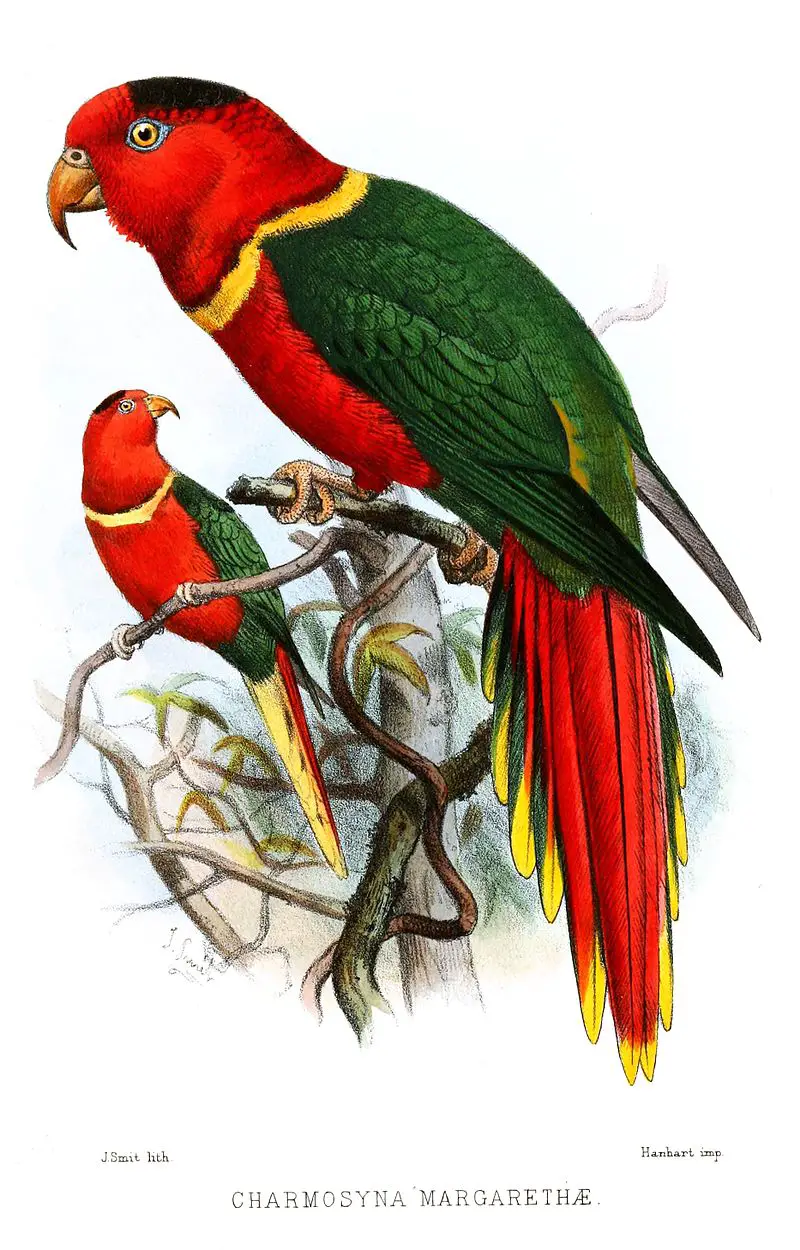
The Duchess Lorikeet is a magnificent species of parrot found throughout the Solomon Islands archipelago.
It has vibrant, multicoloured feathers and an impressive crest on its head which it raises when excited or alarmed.
Its natural habitats are subtropical moist lowland forests, montane forests and plantations. Unfortunately, due to habitat loss this beautiful bird is now considered threatened by conservationists.
As such steps need to be taken in order ensure that future generations can also enjoy observing these delightful creatures living freely in their native environment.Scientific classification:
| Kingdom | Animalia |
| Phylum | Chordata |
| Class | Aves |
| Order | Psittaciformes |
| Family | Psittaculidae |
| Tribe | Loriini |
| Genus | Charmosynoides Joseph et al, 2020 |
| Species | C. margarethae |
12. Finsch’s Pygmy Parrot
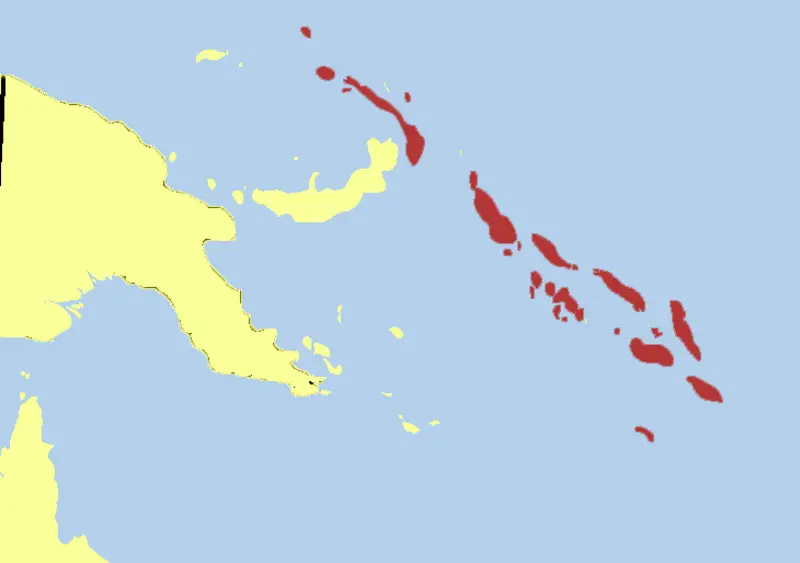
Finsch’s pygmy parrot is a vibrant and lively bird found in tropical rainforest regions of Papua New Guinea, the Solomon Islands, and the Bismarck Archipelago.
They are aptly named after German ethnographer, naturalist, and colonial explorer Friedrich Hermann Ot Finsch who discovered them during his travels.
These small birds have bright emerald green feathers with yellow patches on their wings giving them an iridescent look which makes them stand out in any environment.
The size of these birds varies from 7-8 cm making it one of the smallest species among all parrots.
Despite its diminutive stature they are incredibly active fliers often seen gliding through forests or soaring above trees to get their food sources like fruits and nuts while occasionally feasting upon insects as well.
Their delightful presence adds color to local habitats that many people enjoy watching each day.Scientific classification:
| Kingdom | Animalia |
| Phylum | Chordata |
| Class | Aves |
| Order | Psittaciformes |
| Family | Psittaculidae |
| Genus | Micropsitta |
| Species | M. finschii |
13. Moustached Treeswift
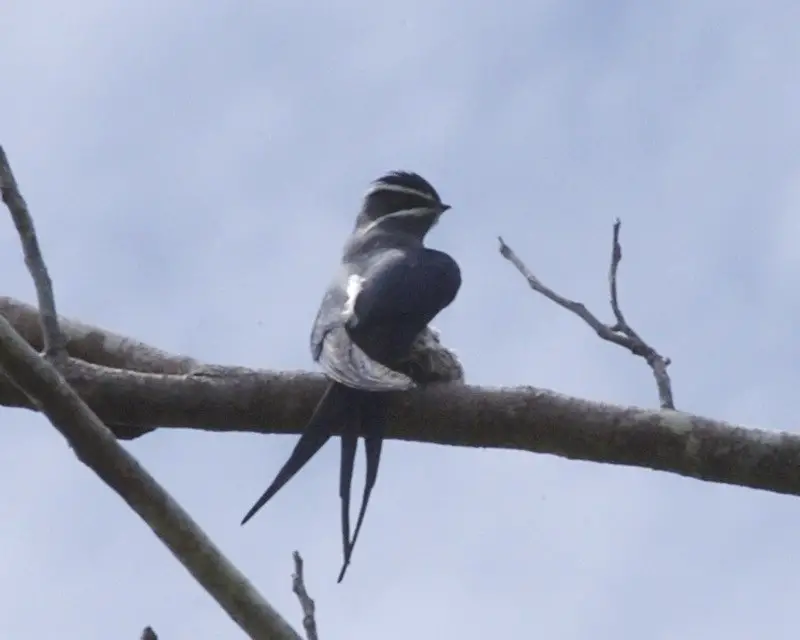
The Moustached treeswift is a species of bird found in the northern Moluccas, New Guinea, Bismarck and Solomon Islands archipelagos.
It belongs to family Hemiprocnidae and its natural habitats are subtropical or tropical moist lowland forests, mangrove forests as well as montane forests.
Its body length ranges from 24 cm – 27 cm with wingspan being approximately 46cm long.
This beautiful creature has moustache-like markings on both sides of its face which makes it look even more attractive when seen through binoculars or cameras.
The upper parts of the Moustached Treeswift are olive green while their underparts have yellowish hues making them stand out against other birds living nearby.
Overall this nocturnal bird is quite magnificent to witness perched atop branches searching for prey at night.Scientific classification:
| Kingdom | Animalia |
| Phylum | Chordata |
| Class | Aves |
| Order | Apodiformes |
| Family | Hemiprocnidae |
| Genus | Hemiprocne |
| Species | H. mystacea |
Also Featured In: Birds that Live Near Halmahera, Waigeo Island Birds
14. Red-Backed Buttonquail
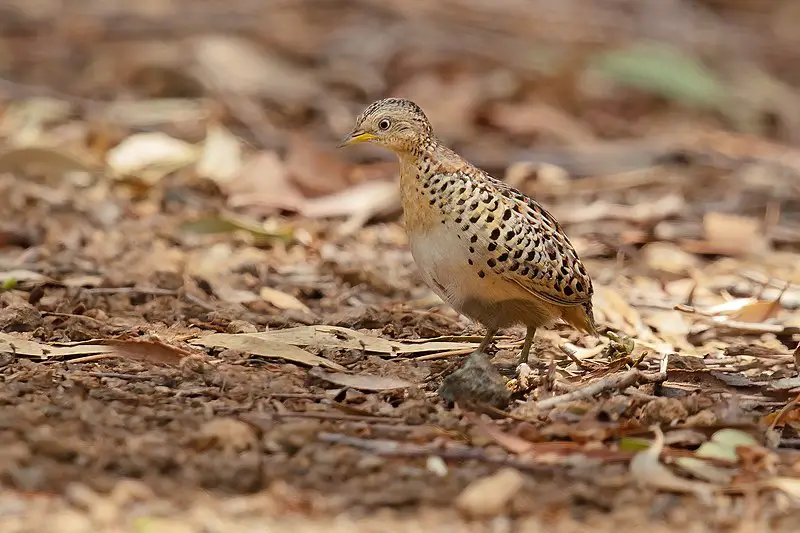
The red-backed buttonquail is a small ground bird found in Australia, Indonesia, Papua New Guinea, the Philippines and the Solomon Islands.
It has fourteen recognised subspecies and can be known by names such as black-backed or orange-breasted buttonquail.
These birds are usually seen alone or in pairs but never more than four together at any one time. With its distinctive mottled brown feathers it blends into its environment seamlessly so that they may be hard to spot even when close up.
The diet of this species consists mainly of seeds which they scratch from the soil using their feet; however insects make up an important part of their diet too.
They live mostly on open grasslands with scattered shrubs for cover where there is plenty of food available throughout the year making them well suited to living in these areasScientific classification:
| Kingdom | Animalia |
| Phylum | Chordata |
| Class | Aves |
| Order | Charadriiformes |
| Family | Turnicidae |
| Genus | Turnix |
| Species | T. maculosus |
15. Cuckooshrike
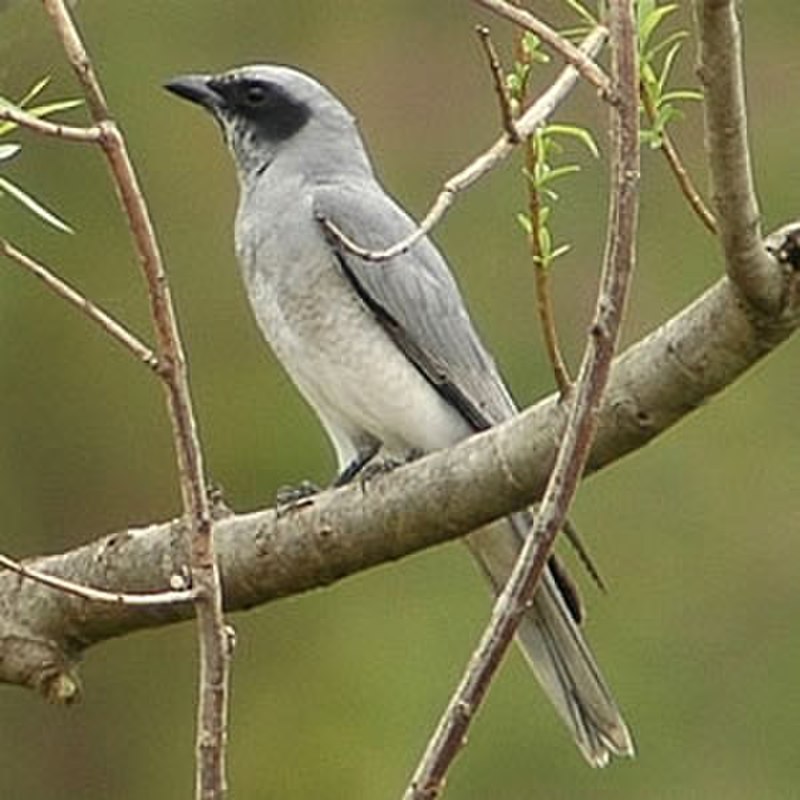
Cuckooshrikes are small to medium-sized passerine birds found mainly in the subtropical and tropical regions of Africa, Asia, and Australasia. They are usually arboreal, feeding on insects or fruit near foliage.
They have a stout bill with long wings and tails that can be used for balancing while perched on branches.
Cuckooshrike plumage is mostly grayish brown but some species may also feature black spots or stripes. The juvenile cuckooshrikes typically show more yellowish coloration than adults do.
These birds form monogamous pairs which often remain together year round defending their territory from other species as well as potential rivals within their own family group.Scientific classification:
| Kingdom | Animalia |
| Phylum | Chordata |
| Class | Aves |
| Order | Passeriformes |
| Infraorder | Corvides |
| Family | Campephagidae Vigors, 1825 |
16. Pied Goshawk
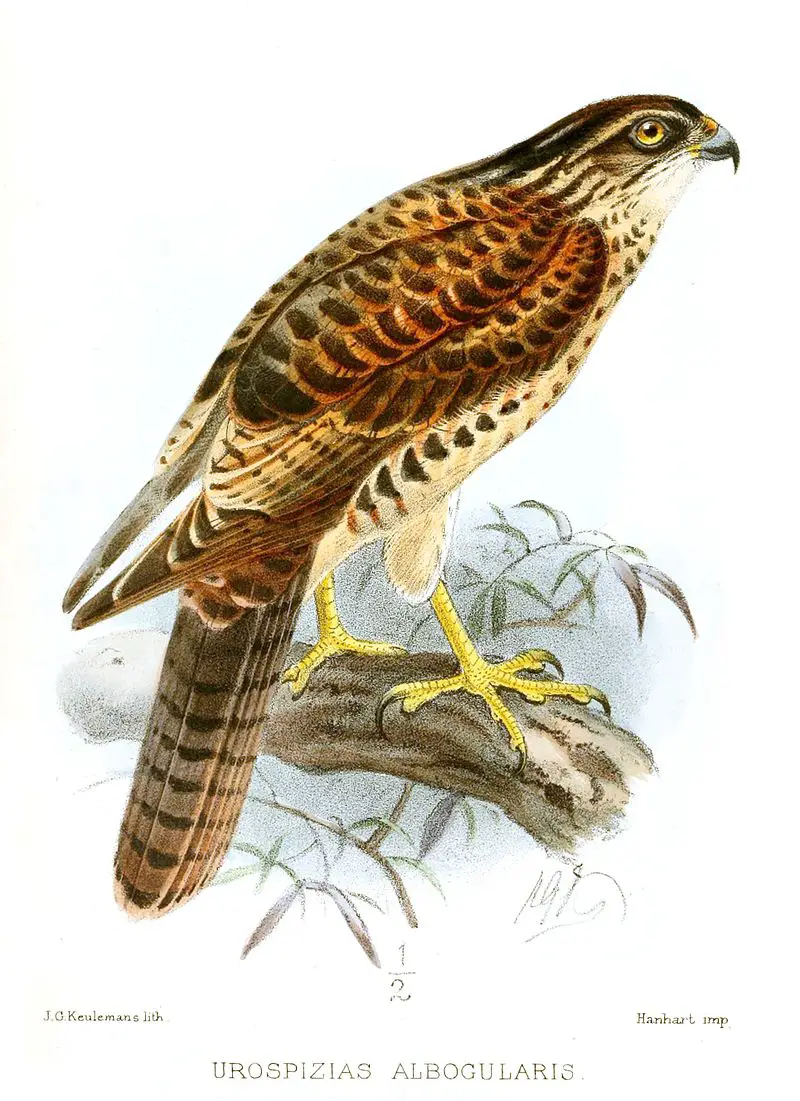
The Pied Goshawk is a species of bird of prey found on Bougainville Island and the Solomon Islands. It has adapted to live in both subtropical or tropical moist lowland forests, as well as montane forests.
This majestic creature’s plumage consists mostly of black with white patches throughout its body; giving it an overall pied appearance.
Its diet mainly consists of small birds, rodents and lizards which it hunts from above using its incredibly sharp vision.
The Pied Goshawk is an impressive example of successful adaptation to unique environments.Scientific classification:
| Kingdom | Animalia |
| Phylum | Chordata |
| Class | Aves |
| Order | Accipitriformes |
| Family | Accipitridae |
| Genus | Accipiter |
| Species | A. albogularis |
17. Pacific Robin
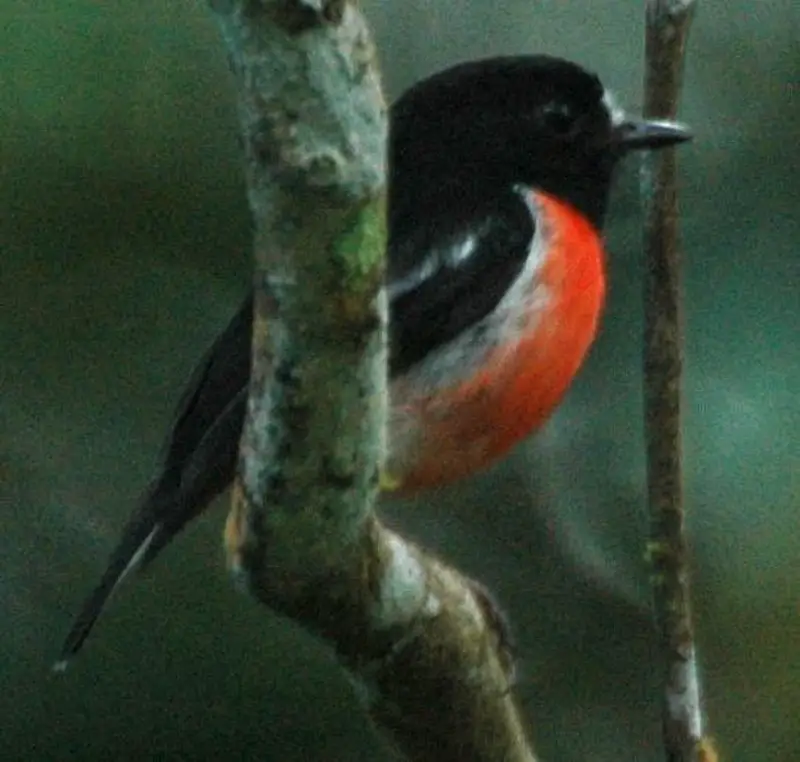
The Pacific robin, a member of the passerine bird genus Petroica, is found in Melanesia and Polynesia. It has distinctive red-breasted plumage similar to that of the scarlet robin found in Australia.
In 1999, taxonomists Schodde and Mason recognised distinctions between these two species leading them to be classified into different genera.
There are currently 13 subspecies of Pacific Robin which display varying colour differences from one another ranging from dull browns through bright oranges and yellows.
The diet mainly consists of insects supplemented by fruit foraging during non breeding seasons as well as occasional visits to garden feeders with suet or mealworms being popular treats on offer.Scientific classification:
| Kingdom | Animalia |
| Phylum | Chordata |
| Class | Aves |
| Order | Passeriformes |
| Family | Petroicidae |
| Genus | Petroica |
| Species | P. pusilla |
18. White-Rumped Swiftlet
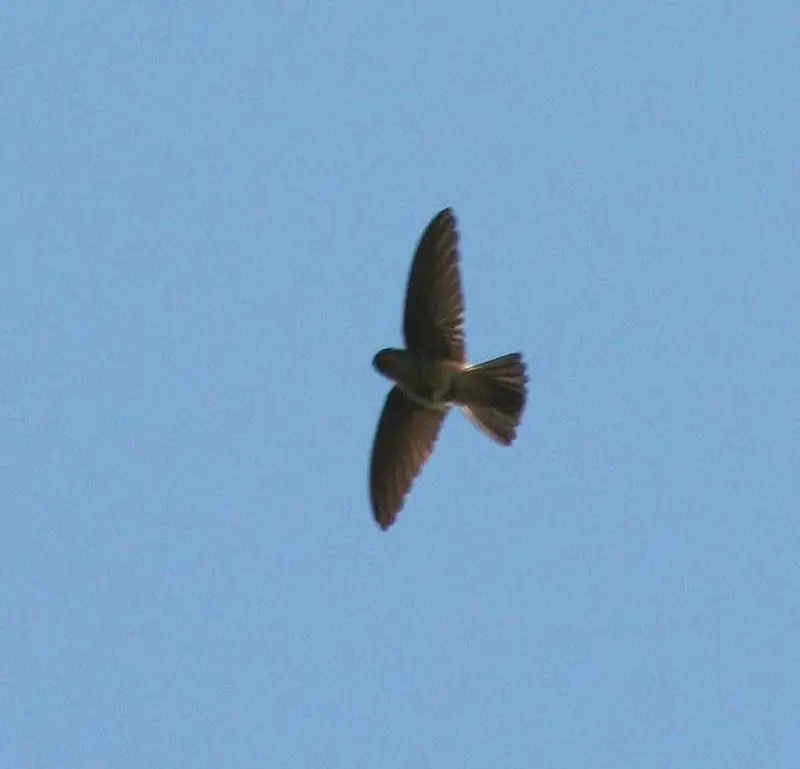
The White-rumped Swiftlet is a species of swift found in the Pacific Islands, including American Samoa, Fiji, New Caledonia and Vanuatu.
It has also been seen in Papua New Guinea and Solomon Islands.
This bird inhabits subtropical or tropical moist lowland forests where it feeds on flying insects such as termites, beetles and flies.
Its main predators are hawks while other threats include deforestation due to logging activities which may reduce its habitat size significantly.
The Australian population was considered separate species (Aerodramus terraereginae) until recently when researchers recognized them as one single species again.
Conservation efforts for this beautiful bird must be done if we want future generations to witness its gracefulness taking flight across our skies.Scientific classification:
| Kingdom | Animalia |
| Phylum | Chordata |
| Class | Aves |
| Order | Apodiformes |
| Family | Apodidae |
| Genus | Aerodramus |
| Species | A. spodiopygius |
19. Shade Bush Warbler
The Shade bush warbler is a species of bird endemic to the island of Makira, in the Solomon Islands. It inhabits moist lowland and montane forests from 600m above sea level.
This small bird feeds on insects found both in undergrowth and on the ground. Its main predators are snakes, cats and rats which inhabit its habitat as well.
The conservation status for this species is currently listed as ‘Least Concern’ by IUCN Red List due to its wide distribution range within its home country despite having relatively few individuals compared with other avian species in that region.
Protection efforts should be made to ensure population numbers remain stable over time so these beautiful creatures can continue bringing joy into our lives.Scientific classification:
| Kingdom | Animalia |
| Phylum | Chordata |
| Class | Aves |
| Order | Passeriformes |
| Family | Cettiidae |
| Genus | Horornis |
| Species | H. parens |
20. Palm Lorikeet
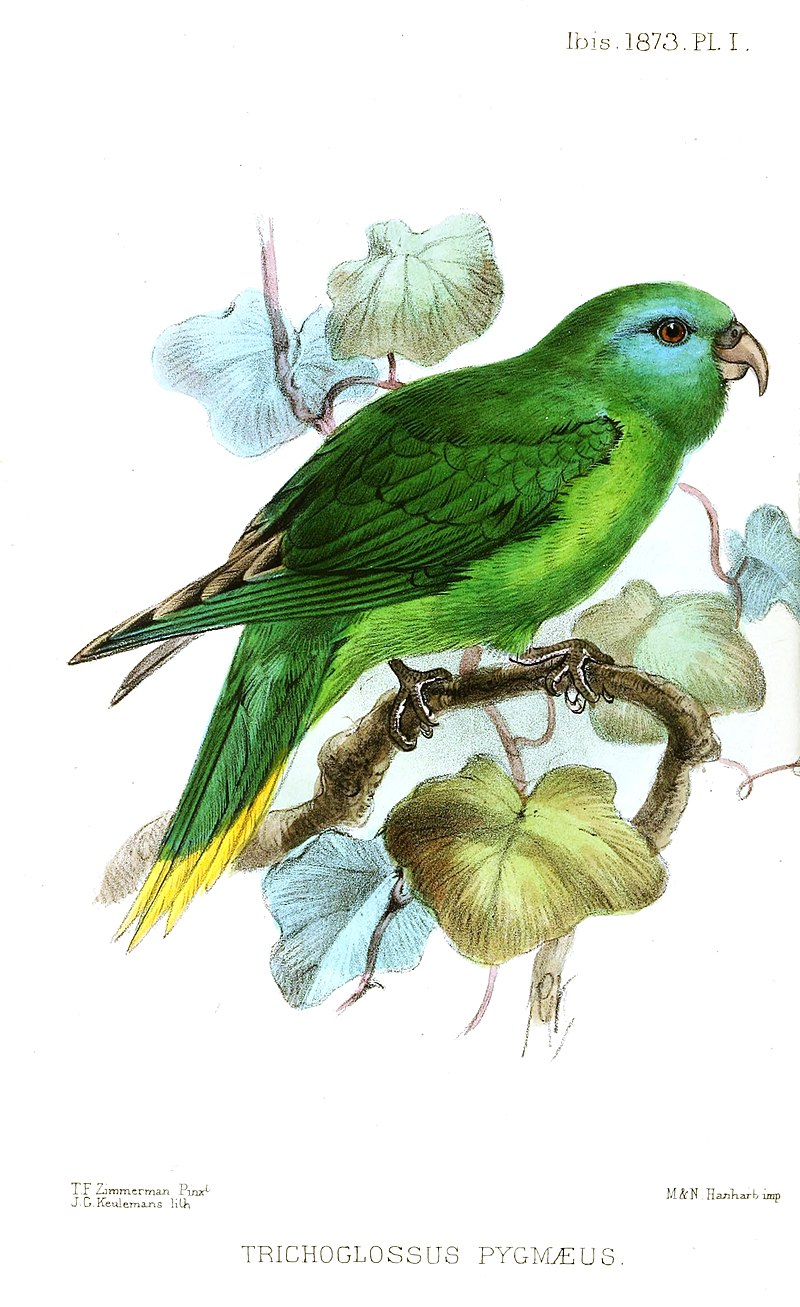
The Palm Lorikeet is a stunning species of parrot native to the Solomon Islands and Vanuatu. It has bright green feathers, with yellow around its face, neck and chest.
Its wings are tipped in blue while its tail feathers have an orange hue at their tips. This colorful bird prefers moist lowland forests or montane forest environments as well as plantations for habitat.
Unfortunately, due to deforestation this lorikeet’s natural habitats are decreasing which makes them increasingly vulnerable to extinction over time if no steps are taken towards conservation efforts now.
The Palm Lorikeet was officially described by German Naturalist Johann Friedrich Gmelin in 1788 who noted it for his incredible beauty and vibrant colors that make him stand out amongst other birds of similar size.Scientific classification:
| Kingdom | Animalia |
| Phylum | Chordata |
| Class | Aves |
| Order | Psittaciformes |
| Family | Psittaculidae |
| Genus | Vini |
| Species | V. palmarum |
21. Sooty Myzomela
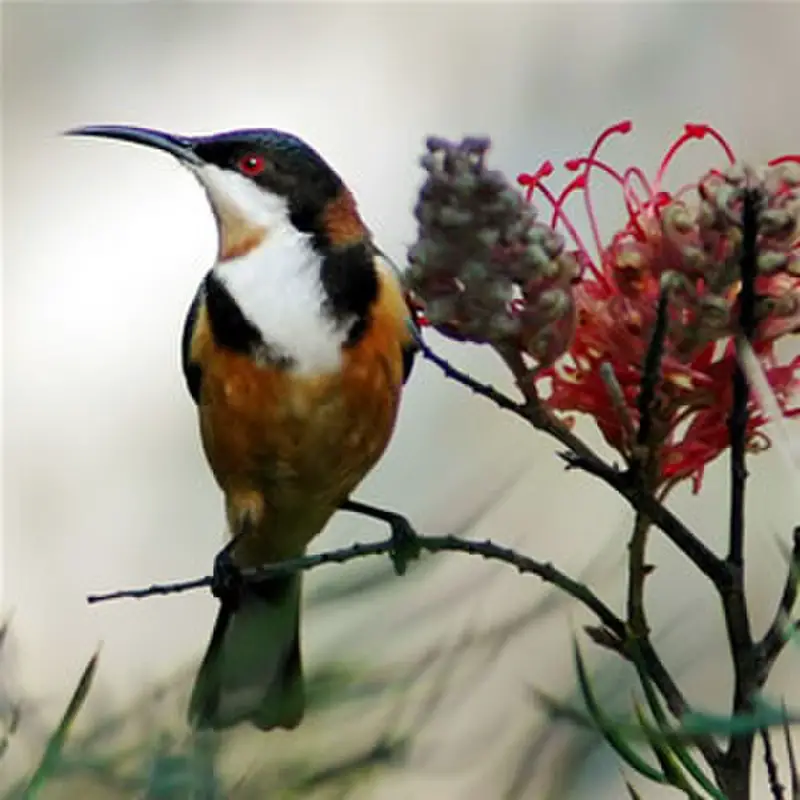
The sooty myzomela is a small bird that belongs to the Meliphagidae family. It is endemic to Makira, an island located in the Solomon Islands in Oceania.
The birds are typically found inhabiting lowland forest and plantations at altitudes of up to 800 m above sea level. They have dark grey plumage with white patches on their wings, while their tails appear short compared to other species within its family.
They feed mainly on nectar and pollen from flowers, as well as insects such as fruit flies and beetles which they glean off tree trunks or foliage during foraging flights among flowering trees or shrubs.
Breeding season occurs between September – December where both parents take part in nesting duties building cup-shaped nests out of grasses lined with feathers or fur before laying two/three eggs per clutch which hatch after 16 days incubation period by either parent taking turns sitting atop nest keeping them warm until hatching time arrives .Scientific classification:
| Kingdom | Animalia |
| Phylum | Chordata |
| Class | Aves |
| Order | Passeriformes |
| Family | Meliphagidae |
| Genus | Myzomela |
| Species | M. tristrami |
22. Kolombangara Leaf Warbler
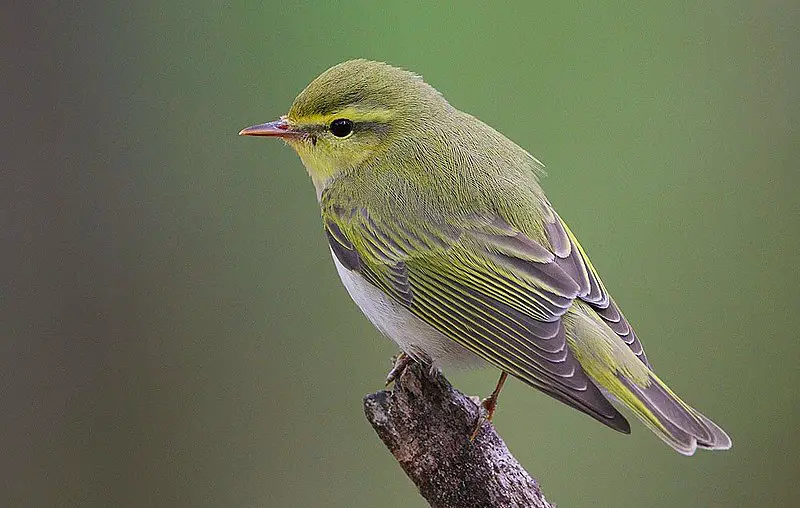
The Kolombangara leaf warbler is a species of Old World warbler only found in the Solomon Islands. It lives in subtropical or tropical moist montane forests and has become threatened due to habitat loss.
The sombre leaf warbler has an olive-brown upper body with greyish white underparts and a yellow throat, making it quite unique amongst other species of birds.
Its diet consists mainly of small insects which it forages for on branches, leaves and stems close to the ground as well as around streams and rivers.
This bird is also known for its distinctive songs that can be heard from far away when singing during their breeding season between May to August each year.
Sadly this beautiful creature may not last much longer if we don’t make more efforts towards protecting its natural habitats from destruction by humansScientific classification:
| Kingdom | Animalia |
| Phylum | Chordata |
| Class | Aves |
| Order | Passeriformes |
| Family | Phylloscopidae |
| Genus | Phylloscopus |
| Species | P. amoenus |
23. Melanesian Flycatcher
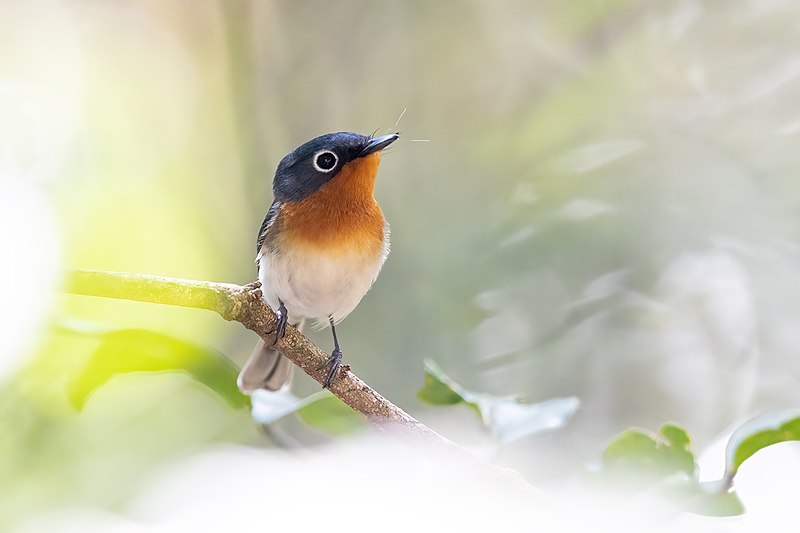
The Melanesian flycatcher is a species of bird belonging to the Monarchidae family and natively found on islands in Melanesia.
It’s closely related to the Vanikoro flycatcher, being known by other names such as broad-billed flycatcher, Caledonian Myiagra Flycatcher or New Caledonian Broadbill.
This small bird has a brown head with white spots near its eyes and an olive green body with yellow tinges along its wings.
Its bill is slightly curved upwards forming a hook shape at the end making it easier for them to catch insects like flies which they usually feed on while perching atop branches during flightless periods.
They are very active birds often seen flying around trees looking for food or nesting materials in order to build their nests which can be made from twigs, grasses among others things depending upon availability.Scientific classification:
| Kingdom | Animalia |
| Phylum | Chordata |
| Class | Aves |
| Order | Passeriformes |
| Family | Monarchidae |
| Genus | Myiagra |
| Species | M. caledonica |
Also Featured In: Birds of New Caledonia,
24. Imitator Goshawk

The Imitator Goshawk, also known as the Imitator Sparrowhawk is a species of bird in the Accipiter family. It is found on three islands in Solomon Islands- Bougainville, Choiseul and Santa Isabel.
Its natural habitats are subtropical or tropical lowland moist forest and montane forests. Sadly its population has been decreasing due to habitat loss caused by deforestation for agricultural purposes, logging activities etc., which puts it at risk of extinction if conservation actions aren’t taken soon enough.
This beautiful sparrowhawk measures up to 30cm long with reddish brown plumage above & white below with black streaks running through it making them quite distinctive from other birds of prey.
They feed mostly on small mammals but they have also been seen scavenging carrion occasionally too. The Imitator goshawk needs our support now more than ever so let’s do all we can to conserve this magnificent creature before it’s too late.Scientific classification:
| Kingdom | Animalia |
| Phylum | Chordata |
| Class | Aves |
| Order | Accipitriformes |
| Family | Accipitridae |
| Genus | Accipiter |
| Species | A. imitator |
25. Silver-Capped Fruit Dove
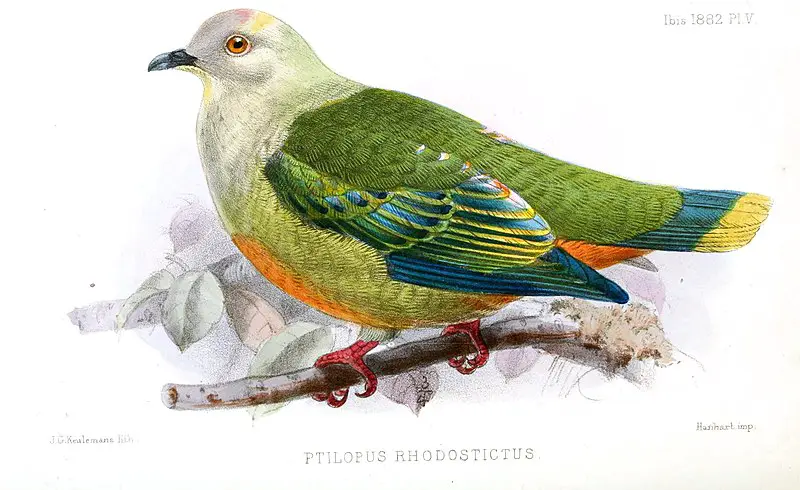
The silver-capped fruit dove is a species of bird that belongs to the family Columbidae. It can only be found in Solomon Islands and prefers subtropical or tropical moist lowland forests as its natural habitat.
This uniquely beautiful creature has distinctive characteristics, such as its light grey head with dark eyes, red iris and chestnut brown neck feathers; plus a green body with white spots on its wings.
The underside of this pretty bird is mostly yellowish orange, while their tail also has some hints of blue hues at times.
Furthermore, they have short legs which help them hop around searching for food like fruits and nuts from trees easily.
They are often seen alone or in small groups flying above the forest canopy looking out for potential meals – making them an interesting sight to behold.Scientific classification:
| Kingdom | Animalia |
| Phylum | Chordata |
| Class | Aves |
| Order | Columbiformes |
| Family | Columbidae |
| Genus | Ptilinopus |
| Species | P. richardsii |
Also Featured In: Silver Birds You Should Know,
26. Crimson-Rumped Myzomela
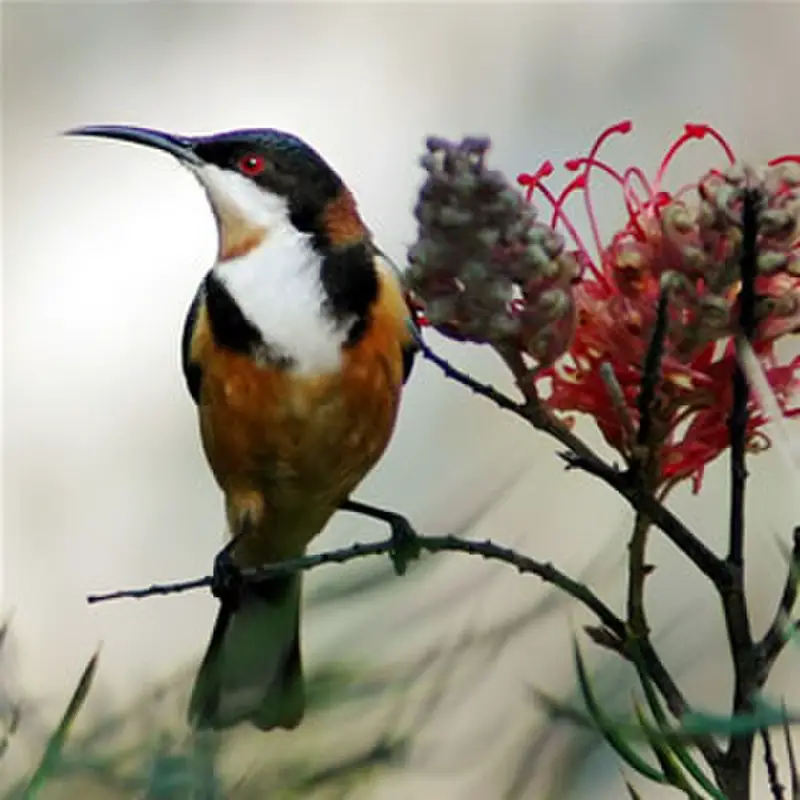
The Crimson-rumped Myzomela is a species of bird endemic to the Western Province of Solomon Islands. It belongs to the Meliphagidae family and has distinct characteristics, such as its crimson rump and yellow vent.
These birds are small in size with an average length between 10 – 12 cm and weigh around 11 grams.
They can most commonly be found living in primary forests or gardens situated at low elevations up to 600 meters above sea level; however these birds have also been spotted foraging at higher altitudes too.
Their diet mainly consists of nectar from flowers, but they may occasionally consume insects as well.
The Crimson-rumpled myzomelas usually form monogamous pairs during breeding season which lasts from August through October each year where both male and female take part in building their nests out of grasses woven together into cup shape structures that hang off branches close by water sources like streams or rivers for easy access when feeding their young ones hatched eggs inside it later on.Scientific classification:
| Kingdom | Animalia |
| Phylum | Chordata |
| Class | Aves |
| Order | Passeriformes |
| Family | Meliphagidae |
| Genus | Myzomela |
| Species | M. eichhorni |
27. Blue-Faced Parrotfinch
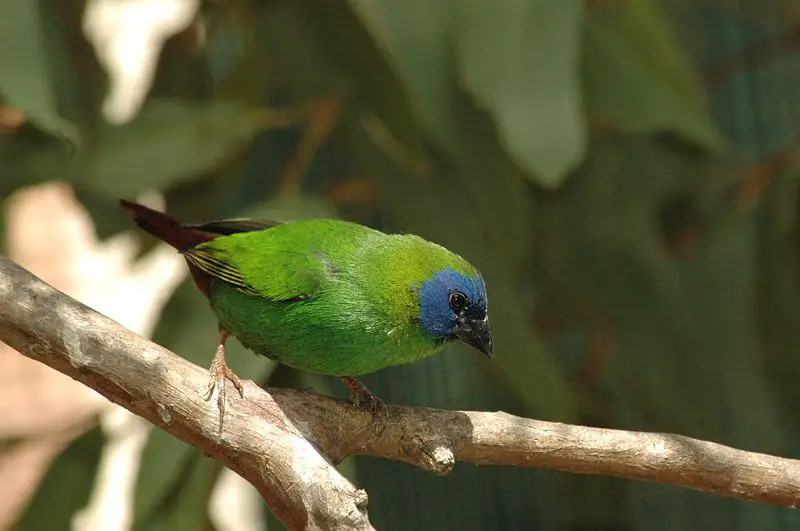
The Blue-faced Parrotfinch is a species of estrildid finch found all across the Pacific, from Australia to Japan and beyond.
It has an estimated global range of 10 million km2, inhabiting subtropical and tropical areas in both mountainous regions and lowland forests.
Its plumage is predominantly blue with white markings on its face as well as some yellow spots or stripes on its wings and tail.
The bird feeds mainly on insects but also eats seeds and fruits when available.
Breeding usually occurs during the rainy season; males construct nests lined with grasses while females lay up to five eggs at once which they incubate for two weeks until hatching takes place.
This species is considered locally common throughout most parts of their distribution area although no population estimates are currently available due to difficulties assessing them over large distances.Scientific classification:
| Kingdom | Animalia |
| Phylum | Chordata |
| Class | Aves |
| Order | Passeriformes |
| Family | Estrildidae |
| Genus | Erythrura |
| Species | E. trichroa |
28. Olive-Backed Sunbird
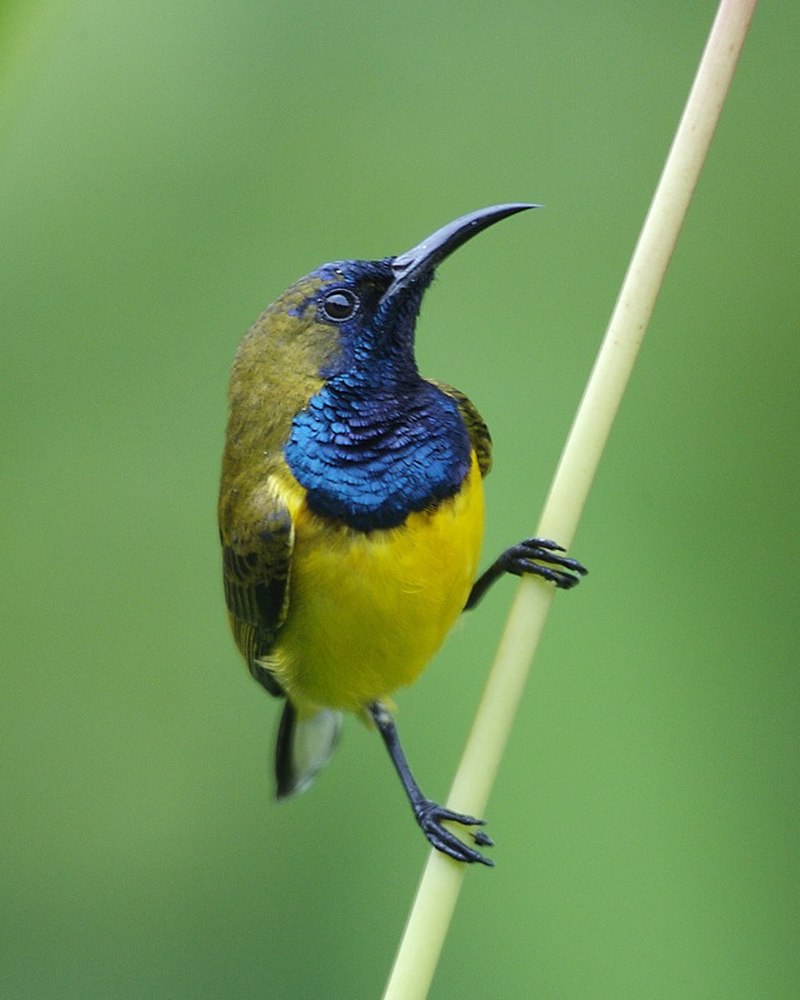
The Olive-backed Sunbird is a vibrant species of sunbird found in Southern Asia and Australia. Its striking yellow underbelly complements its olive upperparts, making it an attractive sight to behold.
First described by Mathurin Jacques Brisson in 1760 based on a specimen from the Philippines, this small songbird loves nectar but will also feed on insects as well as other tiny invertebrates.
It feeds mainly while hovering or perching with its bill pointing downwards – quite an impressive feat.
This bird has adapted to both forested areas and urban gardens meaning they can be seen all over their range.
With conservation efforts in place for this beautiful creature we are sure that the Olive-backed Sunbird will continue to bring joy to our lives for many years yet.Scientific classification:
| Kingdom | Animalia |
| Phylum | Chordata |
| Class | Aves |
| Order | Passeriformes |
| Family | Nectariniidae |
| Genus | Cinnyris |
| Species | C. jugularis |
29. Oriental Dollarbird
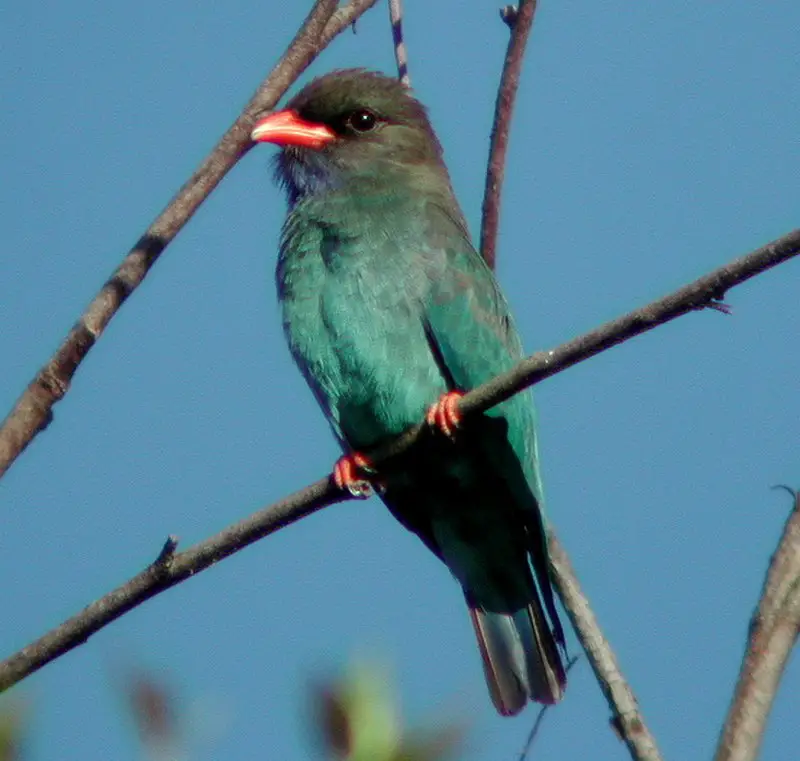
The Oriental dollarbird is a beautiful member of the roller family, easily identified by its pale blue or white coin-shaped spots on its wings.
This species can be found in many places ranging from Australia to Korea, Japan and India.
It was first classified by the Swedish naturalist Carl Linnaeus in 1766 as Coracias orientalis. The bird has an impressive wingspan that helps it soar through the sky with ease.
Its diet consists mainly of insects which it catches mid flight during hunting expeditions for food.
Although shy around people, this mesmerizing creature will fly close enough to humans at times so they can observe them better and appreciate their unique beauty up close.Scientific classification:
| Kingdom | Animalia |
| Phylum | Chordata |
| Class | Aves |
| Order | Coraciiformes |
| Family | Coraciidae |
| Genus | Eurystomus |
| Species | E. orientalis |
30. Ultramarine Kingfisher
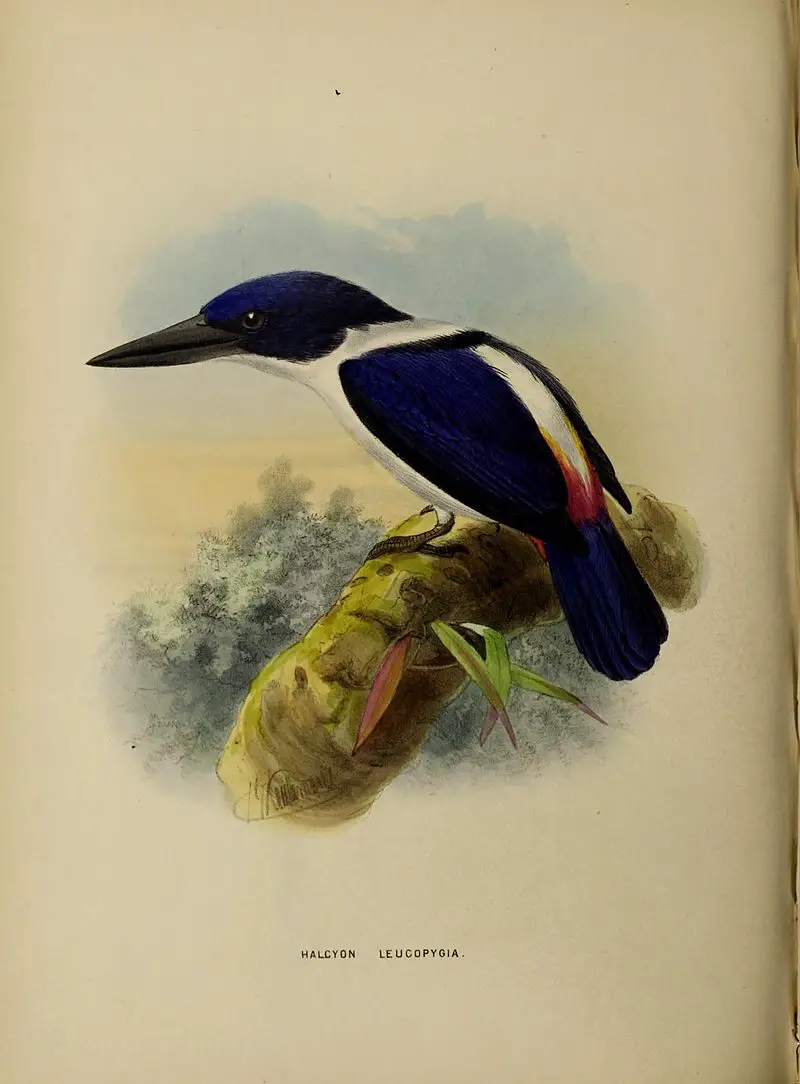
The ultramarine kingfisher is a beautiful and vibrant species of bird belonging to the family Alcedinidae. It can be found in tropical moist lowland forests on Bougainville Island, as well as other Solomon Islands.
The feathers of this majestic creature are an electric blue colour with darker shades along its wings and tail, while its bill is entirely black.
This eye-catching appearance has made it one of the most sought after birds by photographers who want to capture their unique beauty on film.
In addition to being visually stunning, these birds also have excellent hunting skills that they use when catching prey such as fish or insects from nearby branches or water sources.
They are incredibly fast flyers too – so if you ever spot one make sure you keep your eyes peeled for a quick glimpse before it’s gone again.Scientific classification:
| Kingdom | Animalia |
| Phylum | Chordata |
| Class | Aves |
| Order | Coraciiformes |
| Family | Alcedinidae |
| Subfamily | Halcyoninae |
| Genus | Todiramphus |
| Species | T. leucopygius |
31. Hooded Whistler
The Hooded whistler is a species of bird from the Pachycephalidae family. It is found in Guadalcanal, which lies within the Solomon Islands. Its natural habitat consists of subtropical and tropical moist montane forests.
Until 2014, it was thought to be the same as the Bougainville Whistler but since then has been classified as its own distinct species.
The hooded whistler can easily be identified by its distinctive black head plumage with white mottling on top and sides as well as streaks down their throats that give them an almost “hood” like appearance.
They have bright orange-yellow breasts with greyish flanks and short tails that are often fanned out while they fly or hop across branches searching for food such as insects or berriesScientific classification:
| Kingdom | Animalia |
| Phylum | Chordata |
| Class | Aves |
| Order | Passeriformes |
| Family | Pachycephalidae |
| Genus | Pachycephala |
| Species | P. implicata |
32. Malaita Fantail
The Malaita fantail is a species of bird found only in the Solomon Islands. Its scientific name is Rhipidura malaitae and it belongs to the fantail family, which are known for having long tails with many feathers.
This species has a dark grey-brown plumage on its back, while its underside is white or light brown. It also has distinctive white spotting on both wings and tail tips.
The Malaita fantail typically lives in lowland forests but can be seen around villages too; they mainly feed on insects such as flies, moths and beetles that they catch mid-air during their acrobatic flight displays.
These birds also have an interesting courtship ritual during breeding season where males will perform showy aerobatics before mating with females who watch from perches nearby.
Overall this unique species adds beauty to our natural environment when we get glimpses of them flitting about the trees – truly something special indeed.Scientific classification:
| Kingdom | Animalia |
| Phylum | Chordata |
| Class | Aves |
| Order | Passeriformes |
| Family | Rhipiduridae |
| Genus | Rhipidura |
| Species | R. malaitae |
33. Thick-Billed Ground Dove
The Thick-billed Ground Dove is an extinct species of dove, only known from two specimens found in 1882 and 1927.
It was approximately 26 cm long with a beige head, throat and breast mantle along with chestnut upperparts that had a pale purple sheen on them.
The wings were blackish grey while the tail feathers were tipped white giving it a distinctive look.
Unfortunately not much else is known about this mysterious bird as no other sightings have been made since then despite extensive searches for more clues or evidence of its existence.
While we may never know what happened to the Thick-Billed Ground Dove, its unique features will always remain etched in our memory.Scientific classification:
| Kingdom | Animalia |
| Phylum | Chordata |
| Class | Aves |
| Order | Columbiformes |
| Family | Columbidae |
| Genus | Pampusana |
| Species | †P. salamonis |
34. Woodford’s Rail
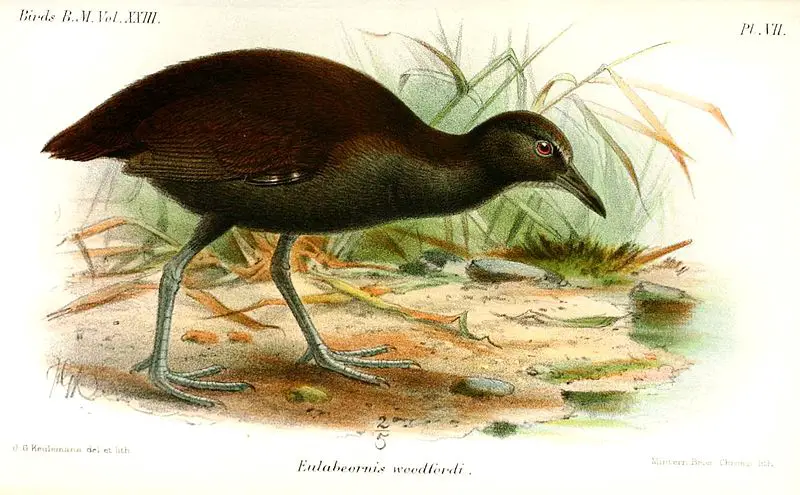
Woodford’s rail is a species of bird found in the Solomon Islands archipelago, and is the only surviving member of its genus (Nesoc). It lives mainly in moist lowland forests and swamps, but can also be found around rivers, freshwater lakes and marshes.
This species has unfortunately been threatened by habitat loss due to human activity such as deforestation.
Woodford’s rail primarily feeds on insects, crustaceans and other invertebrates that it finds either near or underwater. In addition to this diet they will occasionally feed on seeds from plants making them omnivorous creatures.
They are surprisingly good at keeping themselves hidden within their environment with camouflage plumage which helps keep them safe from any predators who may be looking for an easy meal.Scientific classification:
| Kingdom | Animalia |
| Phylum | Chordata |
| Class | Aves |
| Order | Gruiformes |
| Family | Rallidae |
| Genus | Hypotaenidia |
| Species | H. woodfordi |
35. Vanikoro Monarch
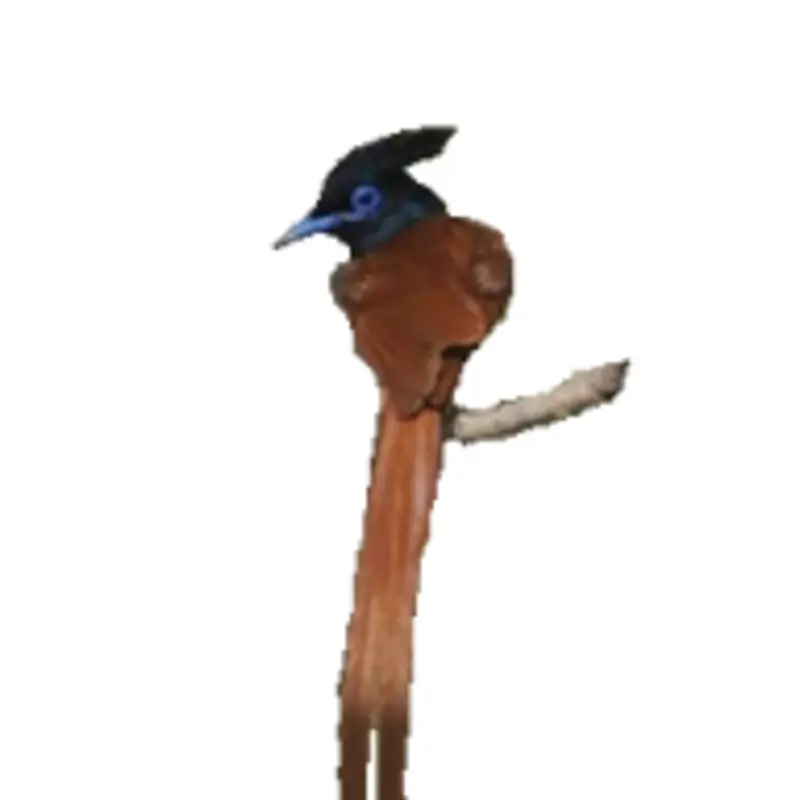
The Vanikoro monarch is a species of bird belonging to the family Monarchidae, which are endemic to the Santa Cruz Islands. It has an alternate name ‘slaty flycatcher’ which it shares with Slaty Monarch.
It inhabits subtropical or tropical moist lowland forests and its population is declining due to habitat loss.
This small bird measures up to 20 cm in length and weighs about 18 grams.
Its plumage resembles greyish-brown coloration on its upperparts whereas whitish underparts speckled with brown spots can be found on its belly area along with two white wingbars at each side of their wings when they take flight.
They feed primarily on insects that make up most of their diet but also consume fruits occasionally as well.
Conservation efforts should be taken in order for this beautiful creature not vanish from existence forever due to human activities destroying their habitatsScientific classification:
| Kingdom | Animalia |
| Phylum | Chordata |
| Class | Aves |
| Order | Passeriformes |
| Family | Monarchidae |
| Genus | Mayrornis |
| Species | M. schistaceus |
36. West Solomons Owl
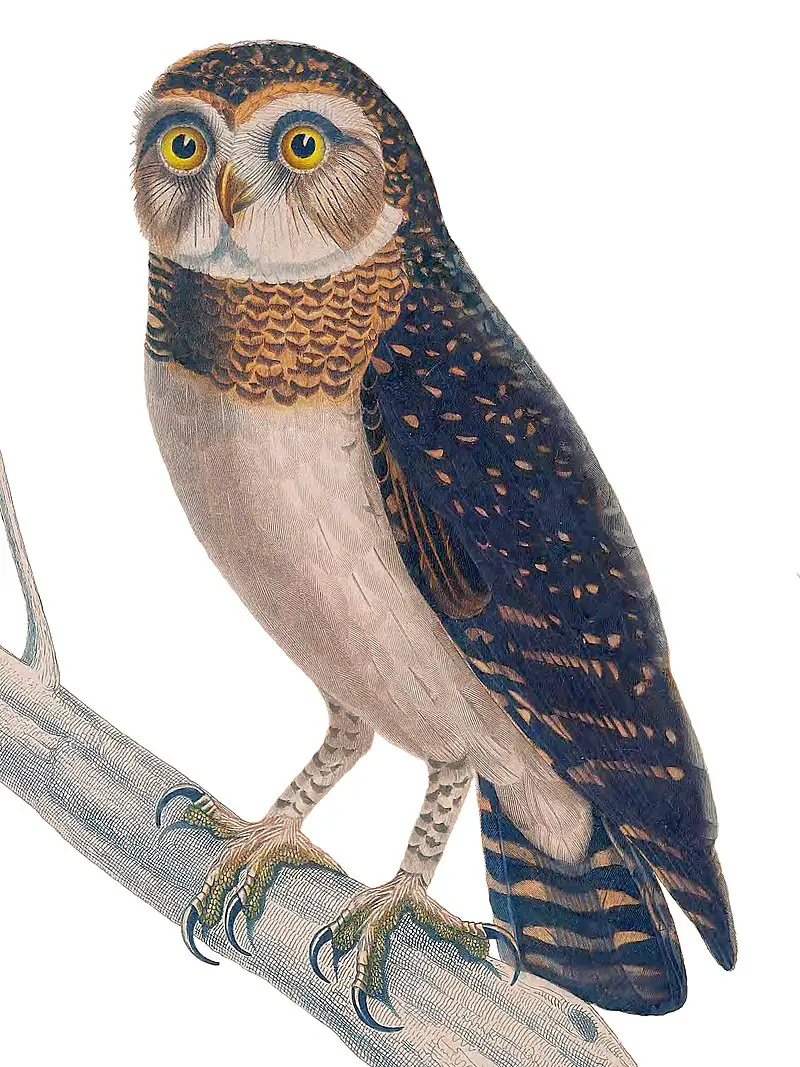
The West Solomons owl is a small to medium-sized bird found in the Solomon Islands. It has a rusty brown upper body with white spots and bars, and its chest is buffy white, sometimes spotted or barred with brown.
The creamy belly of this owl species is unmarked. This stunning bird also possesses a grayish-brown facial disc which contrasts beautifully against its pale eyes that are edged by narrow strips of white feathers.
This unique combination makes it one of the most attractive owls around.
Its size ranges from 23–31 cm (9.1–12.2 inches), making it an ideal companion for nature lovers who wish to observe birds without having to go far out into the wilds.Scientific classification:
| Kingdom | Animalia |
| Phylum | Chordata |
| Class | Aves |
| Order | Strigiformes |
| Family | Strigidae |
| Genus | Athene |
| Species | A. jacquinoti |
37. White-Bellied Cuckooshrike
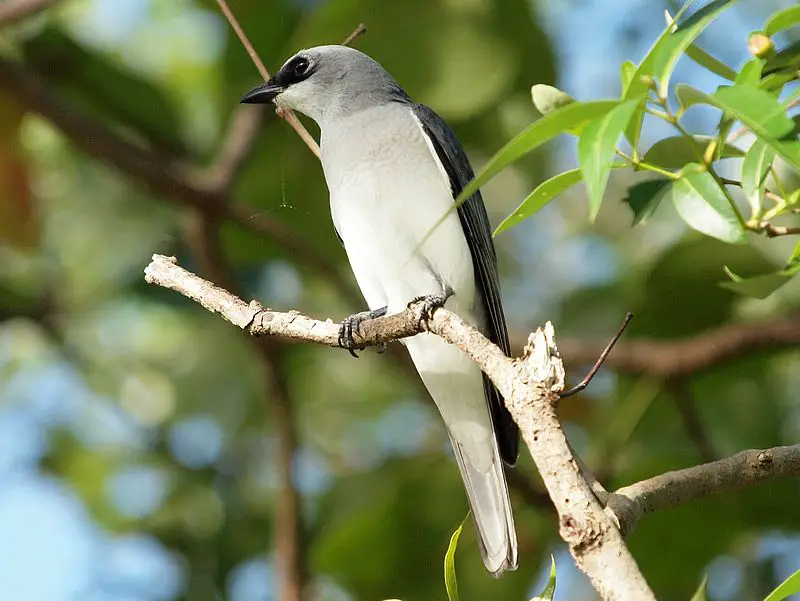
The white-bellied cuckooshrike is a captivating bird found in Australia, the Moluccas, New Guinea and the Solomon Islands.
It has an alluring appearance with its pale blue-grey head and upperparts combined with a short black mask that extends from its beak to its eyes (Lores), finishing off with a fine white rear eye-ring.
Its wings are rounded which help it soar through open woodlands usually as part of mixed species flocks.
This amazing creature enjoys eating insects such as butterflies and moths caught on wing at night or during twilight hours but will also feed on fruit when available.
The White bellied Cuckooshrike is truly an extraordinary example of nature’s beauty.Scientific classification:
| Kingdom | Animalia |
| Phylum | Chordata |
| Class | Aves |
| Order | Passeriformes |
| Family | Campephagidae |
| Genus | Coracina |
| Species | C. papuensis |
Also Featured In: Birds that Charles Darwin Studied, Common Townsville Birds
38. Island Thrush
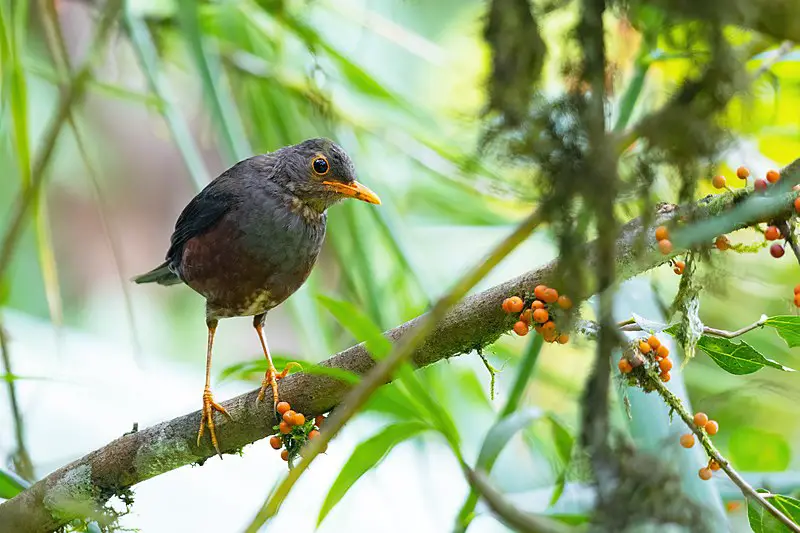
The Island Thrush is a common songbird found in forests throughout Southeast Asia, Melanesia, and Samoa. With nearly 50 subspecies, this species shows great variation in plumage colouration.
Unfortunately, some of these are now threatened or even extinct due to habitat destruction and other human activities.
This bird belongs to the genus Turdus (Linnaeus 1758), which includes many cosmopolitan avian species around the world.
The Island Thrush has strong legs with long toes that allow it to climb easily on branches while searching for food such as insects and fruits. Its loud melodious songs add charm to its natural environment.Scientific classification:
| Kingdom | Animalia |
| Phylum | Chordata |
| Class | Aves |
| Order | Passeriformes |
| Family | Turdidae |
| Genus | Turdus |
| Species | T. poliocephalus |
39. White-Browed Crake
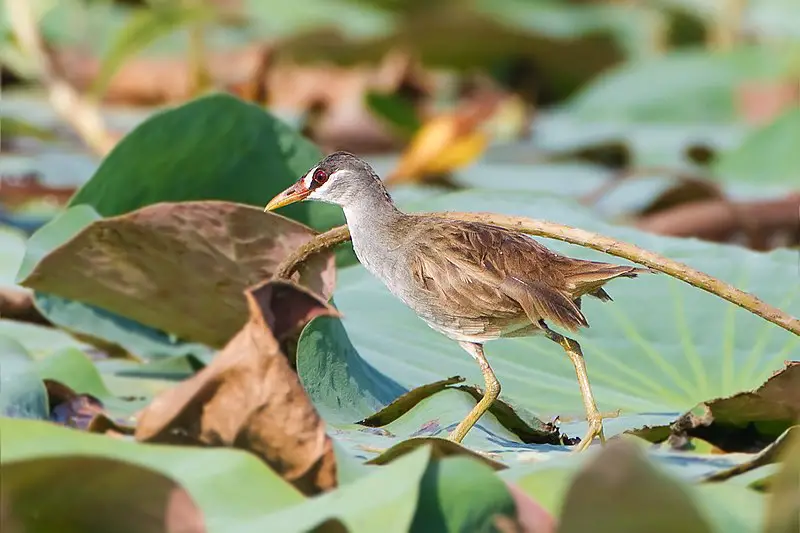
The White-browed Crake is an amazing bird found in many different parts of the world such as Australia, Brunei and even Japan.
It lives mostly in subtropical or tropical mangrove forests, where it can find plenty of food to survive on.
This species has a white head with brown eyes, combined with its slate grey back gives it a unique look that makes them stand out from other birds.
Its diet consists mainly of small invertebrates like insects and larvae but they also feed on fruits when available.
They are shy by nature so if you spot one be sure not to scare it away. Despite their rarity they have been known to breed successfully in captivity and thus have had some success at conservation efforts aimed at preserving this beautiful species.Scientific classification:
| Kingdom | Animalia |
| Phylum | Chordata |
| Class | Aves |
| Order | Gruiformes |
| Family | Rallidae |
| Genus | Poliolimnas Sharpe, 1893 |
| Species | P. cinereus |
40. White-Headed Fruit Dove
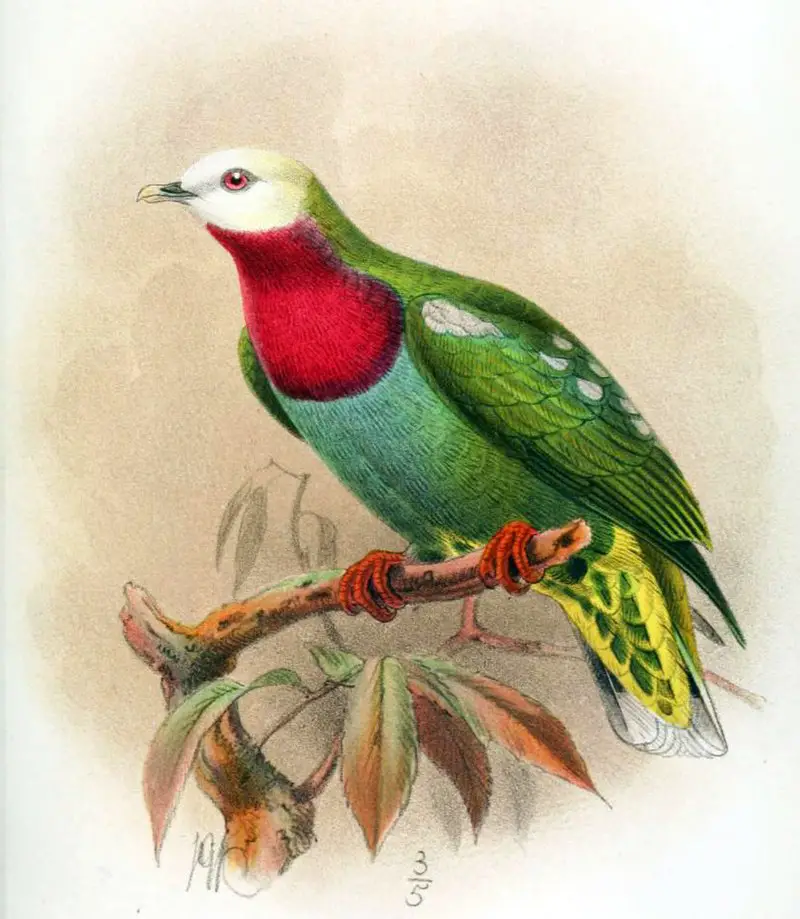
The White-headed Fruit Dove is a member of the Columbidae family and was first described by John Gould in 1856.
It has an impressive white head, purplish red breast patch, grey shoulder patch, olive green upperparts and blue tinted underparts.
This species usually feeds on fruits found in various open woodlands across its native range which includes New Guinea, nearby islands and as far east as Australia’s Cape York Peninsula.
Although they are not considered threatened at present their population numbers remain low due to deforestation caused by logging activities within their natural habitat.
With appropriate conservation efforts this beautiful bird can be safeguarded for generations to comeScientific classification:
| Kingdom | Animalia |
| Phylum | Chordata |
| Class | Aves |
| Order | Columbiformes |
| Family | Columbidae |
| Genus | Ptilinopus |
| Species | P. eugeniae |
41. Claret-Breasted Fruit Dove
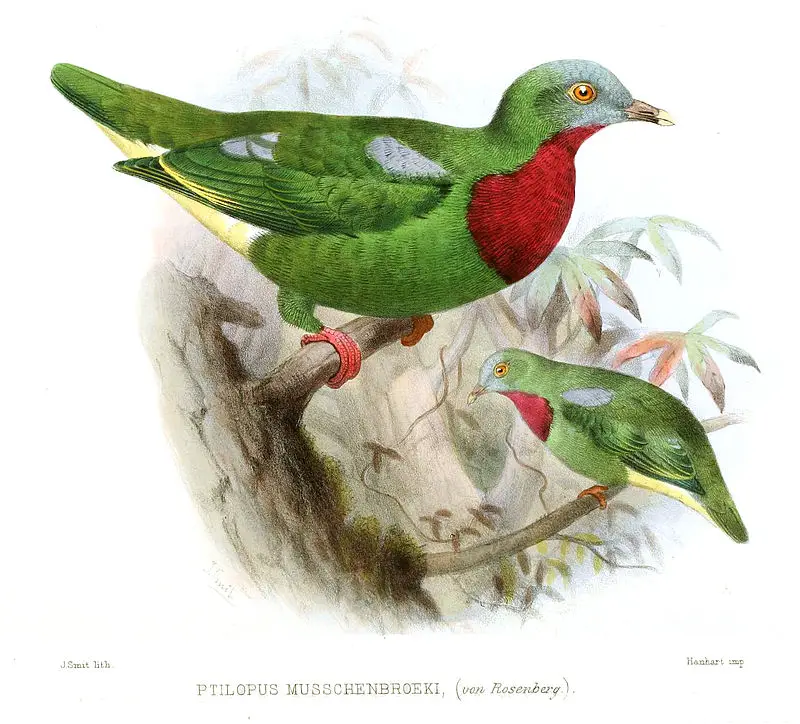
The Claret-breasted Fruit Dove is a stunningly beautiful bird with its deep claret color on its breast and wings, set against vibrant green.
It inhabits subtropical or tropical moist lowland forests from the Moluccas to New Guinea, as well as the Solomon Islands archipelago.
Originally described by French zoologist Mathurin Jacques Brisson in 1760, it has since been identified by many ornithologists for its distinctive appearance.
These birds can be seen eating fruit off of trees while they perch gracefully at high altitudes within their natural habitat.
They also build nests in tree hollows and other cavities, making them difficult to spot unless you know where to look.
The Claret-breasted Fruit Dove is an important part of any healthy rainforest ecosystem; without these colorful creatures our world would not be nearly so vibrant.Scientific classification:
| Kingdom | Animalia |
| Phylum | Chordata |
| Class | Aves |
| Order | Columbiformes |
| Family | Columbidae |
| Genus | Ptilinopus |
| Species | P. viridis |
42. Solomons White-Eye
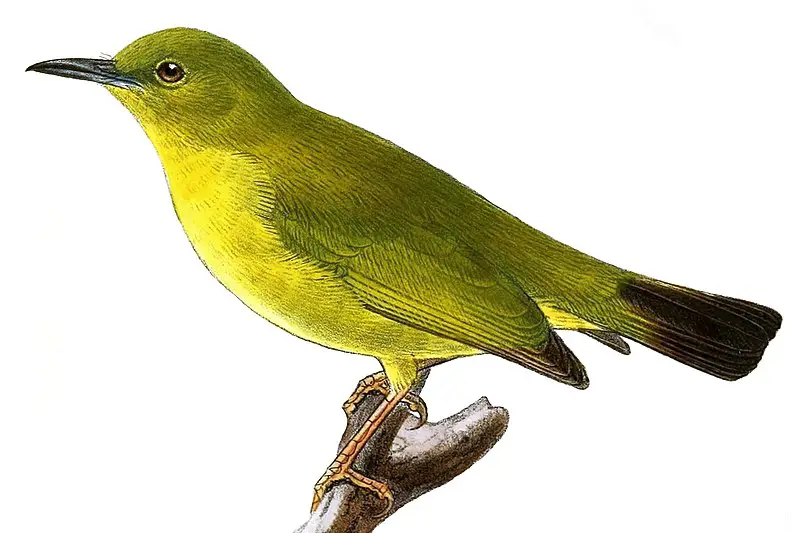
The Solomons White-Eye is a species of bird endemic to the New Georgia Islands in the Solomon Islands. It has striking yellow plumage and a white eye ring, giving it its distinct look.
They inhabit woodland areas up to 1,000 meters above sea level where they feed on insects as well as fruit and nectar from flowers.
The species name “kulambangrae” was given by Australian ornithologist Gregory Mathews who first discovered them in 1912 during an expedition there.
While this small bird may be mistaken for other types of white-eyes due to their similarities, careful observation reveals that they have unique characteristics such as greyish throats which separate them from others in the same family.
Although not currently an endangered species, conservation efforts are necessary if we wish these birds remain part of our planet’s biodiversity for generations to come.Scientific classification:
| Kingdom | Animalia |
| Phylum | Chordata |
| Class | Aves |
| Order | Passeriformes |
| Family | Zosteropidae |
| Genus | Zosterops |
| Species | Z. kulambangrae |
43. Chestnut-Bellied Imperial Pigeon
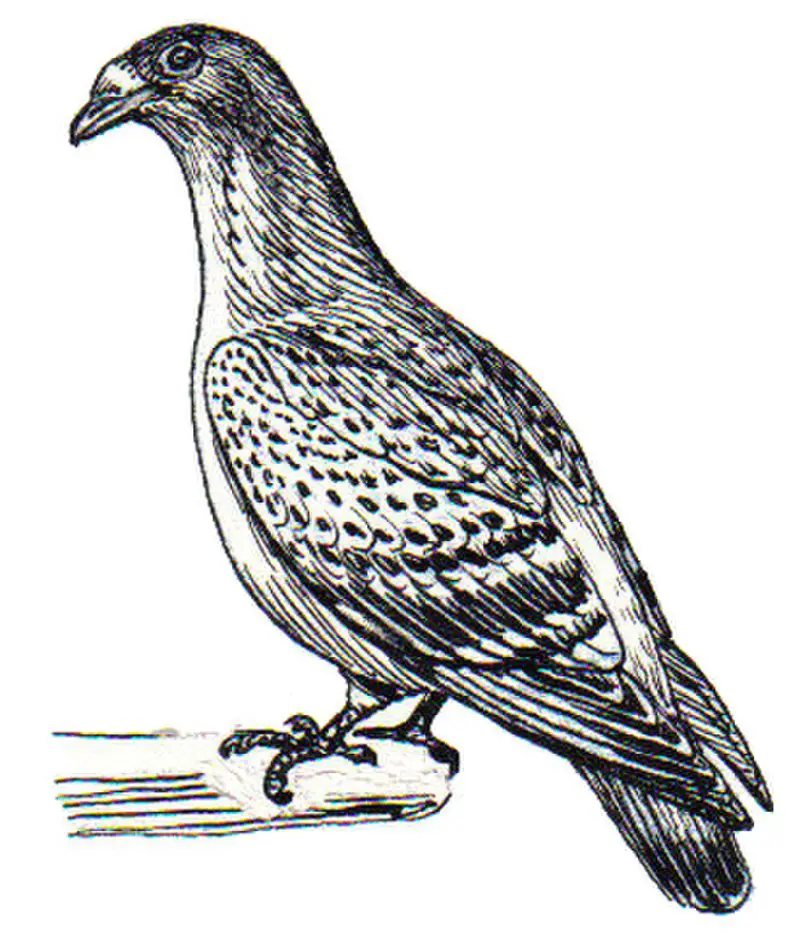
The Chestnut-bellied Imperial Pigeon is a beautiful bird native to the Solomon Islands. It has gray wings and tail, with chestnut feathers on its belly.
This species lives in subtropical or tropical moist lowland forests as well as montane forests, but unfortunately it’s endangered due to habitat loss from human activities such as logging and deforestation.
Therefore we must make sure that these areas are protected for future generations so that this majestic creature can continue living there in peace.
Its diet consists of fruit, berries and nuts which makes them an important seed disperser for many plants found in their natural habitats which helps maintain healthy ecosystems.Scientific classification:
| Kingdom | Animalia |
| Phylum | Chordata |
| Class | Aves |
| Order | Columbiformes |
| Family | Columbidae |
| Genus | Ducula |
| Species | D. brenchleyi |
44. Black-Headed Myzomela
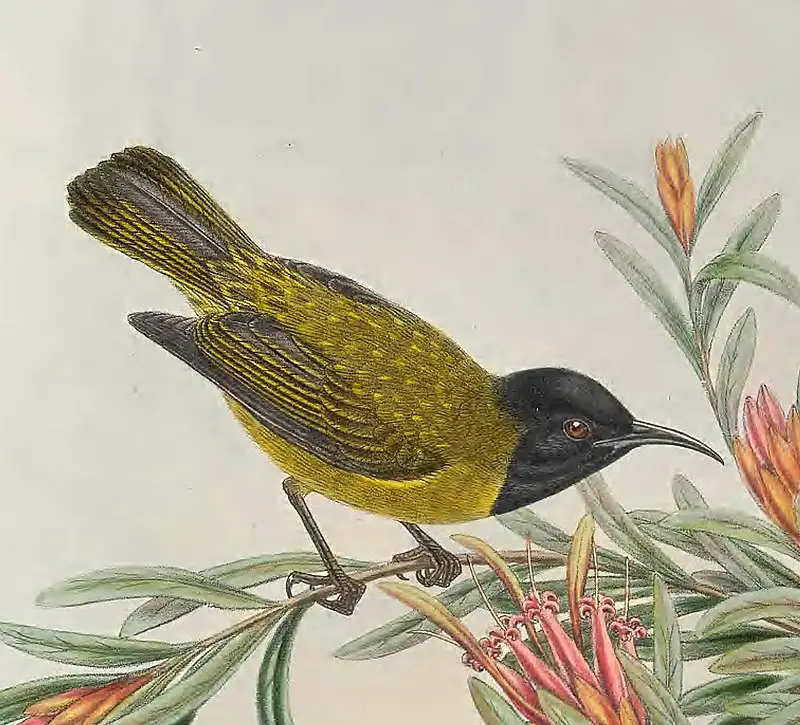
The black-headed myzomela is a beautiful bird species endemic to the Solomon Islands. Its most distinctive feature is its striking black head, and it has a bright red body with yellowish wingbars and tail tips.
The adult males have an orange bill while females usually have dark bills.
This small perching bird lives in subtropical or tropical moist montane forests found at altitudes of up to 1100m, where they can be seen foraging on fruits and nectar from shrubs and trees.
They are also known as ‘flowerpeckers’ due to their diet which consists mainly of flowers, pollen, petals and other floral matter.
Despite being common in their native range they face potential threats from habitat loss due to agricultural activities such as logging or farming so conservation efforts must continue if this unique species is going to survive into the futureScientific classification:
| Kingdom | Animalia |
| Phylum | Chordata |
| Class | Aves |
| Order | Passeriformes |
| Family | Meliphagidae |
| Genus | Myzomela |
| Species | M. melanocephala |
45. Shining Bronze Cuckoo
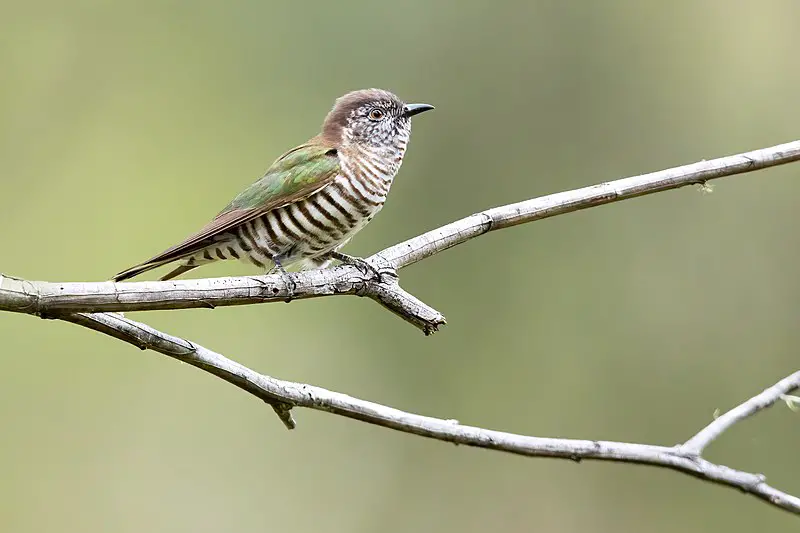
The Shining Bronze Cuckoo is a species of cuckoo found in many areas, including Australia, Indonesia and New Zealand.
It is quite small – only 13 to 18 cm long – but has beautiful plumage with glossy bronze-green on its upperparts and yellowish underparts.
This bird can be seen foraging in trees or shrubs for insects before returning back to its nest which it usually parasitises from other Gerygone species.
Its call consists of harsh croaks followed by an ascending whistle ‘kweeo’.
The diet primarily consists of beetles and caterpillars as well as fruits like figs depending on the season.
They are solitary birds that migrate over short distances during winter months while they largely remain sedentary throughout summer breeding periods when their numbers increase significantly due to nesting activity among tree branches near water sources such as rivers and swamps.Scientific classification:
| Kingdom | Animalia |
| Phylum | Chordata |
| Class | Aves |
| Order | Cuculiformes |
| Family | Cuculidae |
| Genus | Chrysococcyx |
| Species | C. lucidus |
46. Long-Tailed Triller
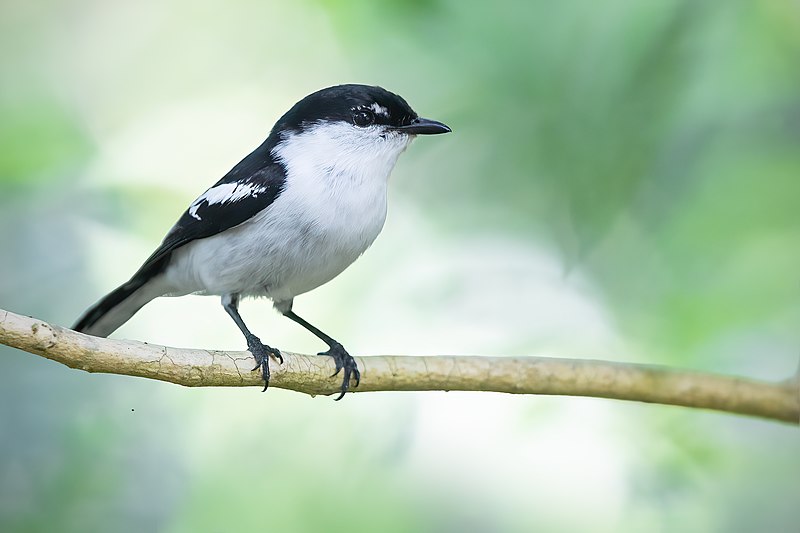
The Long-tailed triller is a species of bird found in New Caledonia, Solomon Islands and Vanuatu.
It belongs to the family Campephagidae and its natural habitats are subtropical or tropical moist lowland forests as well as montane forests.
Sadly, the Norfolk Island subspecies of this bird has become extinct due to human activities such as deforestation.
The long-tailed triller is largely olive green with yellowish eyebrows and wings that have white patches on them when open.
Its tail itself can be up to 20 cm (7 inches) in length which gives it its name.
This beautiful creature loves feeding on insects while perched among foliage or flying through trees searching for food from branches.Scientific classification:
| Kingdom | Animalia |
| Phylum | Chordata |
| Class | Aves |
| Order | Passeriformes |
| Family | Campephagidae |
| Genus | Lalage |
| Species | L. leucopyga |
47. Santa Cruz White-Eye
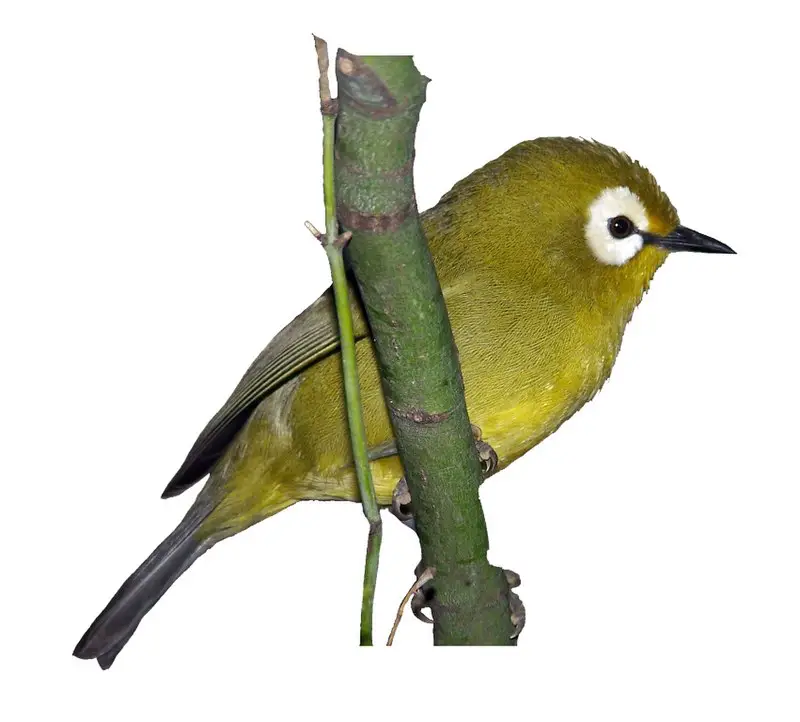
The Santa Cruz white-eye is a species of bird in the Zosteropidae family, native to the Solomon Islands.
It has an olive green back and wings, with a bright yellow belly and distinctive black eye-rings that give it its name.
Its song consists of high pitched trills lasting up to 10 seconds long. The diet mainly consists of fruit, nectar and insects which they search for on branches or within foliage by rapidly flicking their heads from side to side when feeding.
They are also known to flycatch low over vegetation during warmer periods throughout the day as well as participating in mixed species foraging groups where many birds work together cooperatively searching for food sources such as invertebrates among leaves and twigs at higher levels in trees .
This fascinating bird can be seen often near urban areas but prefers dense forest patches due its preference for insect prey items found there rather than open terrainScientific classification:
| Kingdom | Animalia |
| Phylum | Chordata |
| Class | Aves |
| Order | Passeriformes |
| Family | Zosteropidae |
| Genus | Zosterops |
| Species | Z. sanctaecrucis |
48. South Melanesian Cuckooshrike
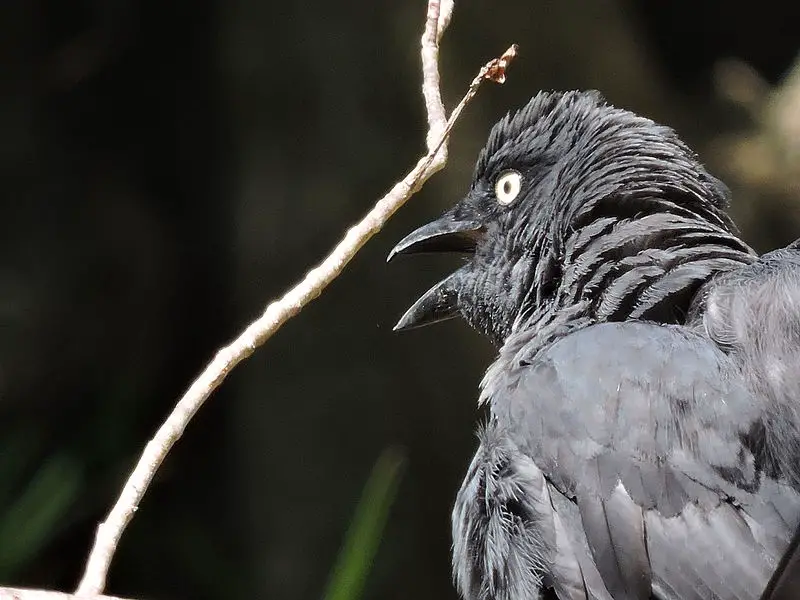
The South Melanesian Cuckooshrike is a large, dark gray bird with a long square tail. It grows to be 32-37 cm in length and can be found in New Caledonia, Bougainville Island, the Solomon Islands and Vanuatu.
The adults of this species have yellow eyes while its young have dark ones. They inhabit sub tropical or tropical moist montane forests as well as subtropical or tropical high altitude grasslands for their home range.
These birds are considered uncommon due to habitat fragmentation caused by human land development activities such as logging and mining operations which make it difficult for them to find food sources they need to survive.
Despite that, these birds still thrive throughout their range thanks in part to conservation efforts being made across the region that seek out ways of protecting them from further harm so future generations will continue on enjoying these impressive creatures.Scientific classification:
| Kingdom | Animalia |
| Phylum | Chordata |
| Class | Aves |
| Order | Passeriformes |
| Family | Campephagidae |
| Genus | Coracina |
| Species | C. caledonica |
49. Yellow-Bibbed Fruit Dove
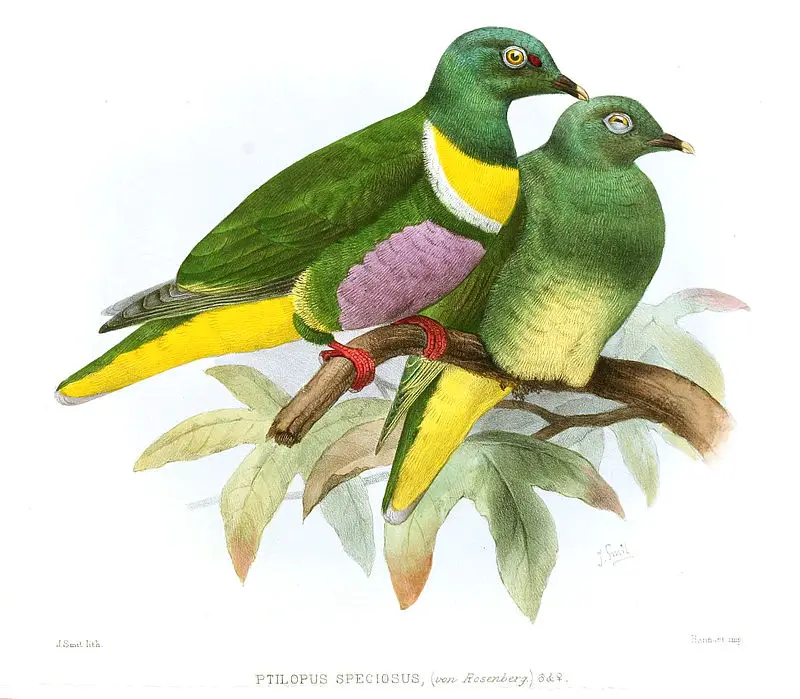
The Yellow-bibbed fruit dove is a species of bird in the Columbidae family, native to the Bismarck and Solomon Islands archipelagos.
It inhabits subtropical or tropical moist lowland forests for its natural habitat.
This distinctive species can be identified by its yellow bib on an overall green body with blue wingtips and reddish undertail feathers.
The Geelvink fruit dove was previously considered conspecific but split from this species as a distinct one according to IOC in 2021 due to physical differences such as bill shape, plumage coloration and size among other features.
These birds are monogamous during breeding season when they build their nest using twigs near trees or bushes where they lay two white eggs that hatch after 14 days of incubation period shared between both parents until fledging stage takes place at 23 days old chicksScientific classification:
| Kingdom | Animalia |
| Phylum | Chordata |
| Class | Aves |
| Order | Columbiformes |
| Family | Columbidae |
| Genus | Ptilinopus |
| Species | P. solomonensis |
50. White-Billed Crow
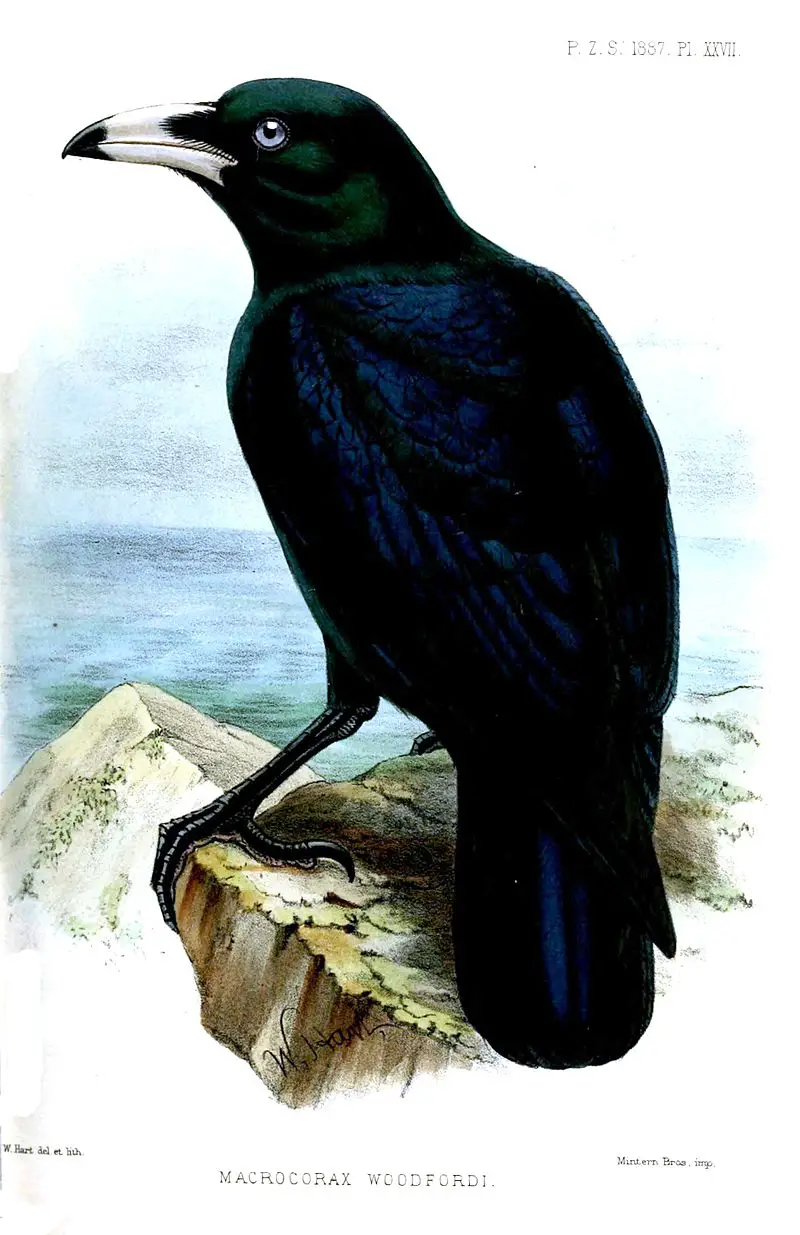
The white-billed crow is a member of the crow family found on the Solomon Islands. It has a short and stocky body, measuring 40–41 cm in length with a short, squared-off tail and large head.
What makes it unique is its deep curved ivory bill which has darker tip. The dark nasal bristles framing this pale coloured bill make it distinctive from other birds in its species.
Its feathers are glossy black overall except for some brownish tinge around the neck area while legs and feet are grey-black in colour.
This bird inhabits primarily moist lowland forests but can also be found near rural gardens or plantations where food sources like fruits, insects and small animals are more easily available to themScientific classification:
| Kingdom | Animalia |
| Phylum | Chordata |
| Class | Aves |
| Order | Passeriformes |
| Family | Corvidae |
| Genus | Corvus |
| Species | C. woodfordi |